Photo

Are you worried about your WordPress website's security and want to protect it from malware and hacking attacks? Look No Further! Our WordPress Malware Removal & Security Service provides you with top-notch website security services. We guarantee to remove any malware from your website and fix any issues within 24 hours. We will also add additional security measures to your website to prevent any future attacks. OUR SERVICES INCLUDE: Malware Removal Fixing Redirect Issues Blacklist Notification Removal Updating Site Software & Plugins. In Addition To Malware Removal, we also offer Website Security Services such as Brute Force Attack Prevention, Database Security, Website File Security, And Firewall Security. With 8+ years of professional experience, we guarantee to provide you with the highest quality service at the lowest cost. We offer a 24-hour express delivery and a 100% MONEY-BACK GUARANTEE. Protect your website now with our professional WordPress security services. Contact Us To Get Started Today! #WordPress #WordPressDeveloper #WordPressMalwareRemoval #WordPressSecurityExpert (at Abuja, Nigeria) https://www.instagram.com/p/CqAuGuhDcWp/?igshid=NGJjMDIxMWI=
0 notes
Photo

🏡 10 Tips For Optimizing Your Real Estate Website For Lead Generation 📩. As a real estate agent, your website is 1 of the most critical tools in generating leads & growing your business. But how can you optimize your website to attract & convert potential clients into leads? I'll share 10 tips for optimizing your real estate website for lead generation. 1️⃣ Create A User-friendly Website: Your website should be easy to navigate and user-friendly. Make sure it's responsive, loads quickly, and has a clear layout that makes it easy for visitors to find what they're looking for. #realestateagent #RealEstateMarketing #RealEstate 2️⃣ Optimize For Search Engines: Use keywords & phrases related to your area & niche throughout your website's content to improve your search engine rankings. Consider using local SEO tactics to target potential clients in your area. #SEOExpert #SEOAgency #digitalmarketingstrategy 3️⃣ Offer Valuable Content: Provide valuable content that addresses your client's pain points and offers solutions. This could include blog posts, videos, and helpful resources related to the real estate market. #SalesFunnel #ContentMarketing #videomarketing #SEO #Oscars 4️⃣ Use Lead Capture Forms: Use lead capture forms strategically throughout your website to encourage visitors to provide their contact information. Offer something of value in exchange, such as a free home valuation or a downloadable guide. 5️⃣ Highlight Client Testimonials: Display client testimonials prominently on your website to build trust and credibility with potential clients. 6️⃣ Showcase Your Expertise: Use your website to showcase your expertise in your niche. This could include highlighting your experience and qualifications, as well as any awards or recognition you've received. 7️⃣ Include Clear Calls-to-action: Use clear calls-to-action (CTAs) throughout your website to guide visitors toward becoming leads. This could include CTAs to schedule a consultation or download a free resource. 8️⃣ Offer Virtual Tours: Use virtual tours to give potential clients a comprehensive view of your properties, especially if they're unable to visit in person. Continue Reading On Twitter (at Abuja, Nigeria) https://www.instagram.com/p/CpyESdNjjGX/?igshid=NGJjMDIxMWI=
#realestateagent#realestatemarketing#realestate#seoexpert#seoagency#digitalmarketingstrategy#salesfunnel#contentmarketing#videomarketing#seo#oscars
0 notes
Photo

🚨 ATTENTION ALL WORDPRESS WEBSITE OWNERS 🚨 Did You Know? WordPress was the most commonly-hacked CMS (content management system) in 2021 & 2022, according to Sucuri’s annual hacked website report. Over 95.6% of infections detected by Sucuri were on websites running WordPress. How Secure Is Your WordPress Website? Are You Concerned About The Security Of Your Website? LOOK NO FURTHER! We are here to provide top-notch WordPress security services tailored to your needs. Don't Wait Until It's Too Late! Let Us Protect Your Website And Give You Peace Of Mind. Contact us today to learn more about our WordPress security services. #WordPressSecurity #WebsiteProtection #OnlineSafety #SecureYourSite #PeaceOfMind #CyberSecurity #OnlinePrivacy #StayProtected #ProtectYourBusiness #OnlineSecurityExpert #WebsiteOwners #WordPressWebsiteOwners (at Abuja, Nigeria) https://www.instagram.com/p/CpwlQ04Dt46/?igshid=NGJjMDIxMWI=
#wordpresssecurity#websiteprotection#onlinesafety#secureyoursite#peaceofmind#cybersecurity#onlineprivacy#stayprotected#protectyourbusiness#onlinesecurityexpert#websiteowners#wordpresswebsiteowners
0 notes
Photo

3 Reasons Why You Need an Effective Real Estate Website 🏠 In today's digital age, having an effective real estate website is essential for any real estate professional. A well-designed & optimized website can help you reach more potential clients, showcase your properties, & increase your online presence. Here are three reasons why you should have an effective real estate website, along with tips for designing a website that is visually appealing, user-friendly, & optimized for search engines. 1: Reach More Potential Clients 🌐 An effective real estate website can help you reach more potential clients than traditional marketing methods. By having a website, you can showcase your properties, provide valuable information about the local real estate market, & offer resources for buyers & sellers. Make sure your website is optimized for search engines to increase visibility and drive traffic to your site. #RealEstateWebsite #SEO 2: Showcase Your Properties 🏡 Your website is a great platform for showcasing your properties to potential buyers. Make sure your website is visually appealing & user-friendly, with high-quality photos & detailed property descriptions. Consider adding virtual tours or 3D floor plans to enhance the user experience and provide a more immersive viewing experience. #PropertyListings #VirtualTours Create Effective Landing Pages 📄 A landing page is a web page designed specifically to convert visitors into leads. When designing a landing page for a property listing, make sure it is clear, concise, & visually appealing. Include high-quality photos, a detailed property description, & a clear call to action. Consider offering a free resource or incentive to encourage visitors to provide their contact information. #LandingPages #LeadGeneration 4: Conclusion 🎉 Having an effective real estate website is crucial for any real estate professional. To maximize your online presence & reach more potential clients, make sure your website is visually appealing, user-friendly, and optimized for search engines. Showcase your properties with high-quality photos and detailed descriptions, & create effective landing pages to convert visitors into leads. (at Abuja, Nigeria) https://www.instagram.com/p/CpwiWjaDVzo/?igshid=NGJjMDIxMWI=
0 notes
Photo

3 Reasons Why You Need an Effective Real Estate Website 🏠 In today's digital age, having an effective real estate website is essential for any real estate professional. A well-designed & optimized website can help you reach more potential clients, showcase your properties, & increase your online presence. Here are three reasons why you should have an effective real estate website, along with tips for designing a website that is visually appealing, user-friendly, & optimized for search engines. 1: Reach More Potential Clients 🌐 An effective real estate website can help you reach more potential clients than traditional marketing methods. By having a website, you can showcase your properties, provide valuable information about the local real estate market, & offer resources for buyers & sellers. Make sure your website is optimized for search engines to increase visibility and drive traffic to your site. #RealEstateWebsite #SEO 2: Showcase Your Properties 🏡 Your website is a great platform for showcasing your properties to potential buyers. Make sure your website is visually appealing & user-friendly, with high-quality photos & detailed property descriptions. Consider adding virtual tours or 3D floor plans to enhance the user experience and provide a more immersive viewing experience. #PropertyListings #VirtualTours Create Effective Landing Pages 📄 A landing page is a web page designed specifically to convert visitors into leads. When designing a landing page for a property listing, make sure it is clear, concise, & visually appealing. Include high-quality photos, a detailed property description, & a clear call to action. Consider offering a free resource or incentive to encourage visitors to provide their contact information. #LandingPages #LeadGeneration 4: Conclusion 🎉 Having an effective real estate website is crucial for any real estate professional. To maximize your online presence & reach more potential clients, make sure your website is visually appealing, user-friendly, and optimized for search engines. Showcase your properties with high-quality photos and detailed descriptions, & create effective landing pages to convert visitors into leads. (at Abuja, Nigeria) https://www.instagram.com/p/Cpwe6qnDV2G/?igshid=NGJjMDIxMWI=
0 notes
Photo

I am a Digital Marketing Expert with expertise in SEO, WordPress Security, PayPerClick, Google Ads, Facebook/Instagram Ads, YouTube Ads/SEO, Google My Business Ads/SEO, Sales & Marketing Strategy, Consultancy, etc. Follow me as I will be posting marketing & sales content. #explore #explorepage #exploremore #explorepage✨ #exploreeverything #explorecanada (at Abuja, Nigeria) https://www.instagram.com/p/Cpwb0c3jUgg/?igshid=NGJjMDIxMWI=
0 notes
Text
A Stay at The Eccleston Square Hotel in Belgravia
If you have a penchant for personalised, boutique hotels, you might like to check out the Eccleston Square Hotel. This family-run hotel located in SW1 opened in 2011 when Olivia Byrne decided to create one of the most ‘technologically advanced hotels’ in London. At 23, the Paris-born entrepreneur was dubbed one of the youngest hoteliers of the time.
Since then, the 4.5-star hotel has picked up quite a few accolades. Conde Nast Traveler listed it in the top 15 best boutique hotels in London and it picked up their Reader’s Choice Award in 2016. You’ll also find many articles applauding the hotel’s various hi-tech features and massage beds that come with every room.
With no plans to travel far over the Easter weekend, BC and I took up the opportunity to enjoy a one-night stay here and make the most of some ‘London time’ following our recent move. Here’s how it went.
Eccleston Square Hotel: The Location
The location of Eccleston Square Hotel is definitely one of its strengths. Eccleston Square is located in the SW1V area of London. And overlooking a leafy garden, it feels surprisingly quiet, but is actually, very accessible. Victoria coach, railway and tube stations are just a five-minute walk away. And you have Pimlico, Belgravia and the attractions of Westminster right on your doorstep. It’s a great location for anyone visiting the theatres in Victoria too.
The building itself is a Grade II listed Georgian townhouse, which is immediately appealing for travellers who appreciate a bit of character, although, as you’ll read below, this is a super modern hotel inside.
Interestingly, you’ll find the house that Winston Churchill lived in, just a few doors down and I’m told that Queen Victoria’s granddaughter once lived in the building that is now the hotel.
How’s that for a bit of history?
The Arrival
It was very quiet when we first arrived, and we waited a few minutes at reception for someone to greet us. Once they did, the front-of-house staff were very warm and friendly, and check-in was quick and seamless. They’ve taken a very contemporary approach at the Eccleston Square Hotel, with lots of monochrome, marble and sparkling chandeliers.

Once we’d checked in, one of the hotel staff took us up to our room on the first floor and gave us a thorough explanation of the technology and services in the room, which was a nice touch.
The hotel entrance hall
The entrance to our guest room at the Eccleston Square Hotel
The guestroom interiors & amenities
The guestroom interiors, much like the hotel reception, are contemporary and quite business-like with dark wooden wardrobes and furniture, grey carpets and black faux-fur cushions and throws.
There are two fluffy towelling robes and slippers in the wardrobe and guests who have booked directly through the hotel can enjoy a complimentary mini-bar (choice of Evian water, two types of beer and soft drinks). There’s also a Nespresso coffee machine and while there’s no kettle, they do offer a free 24-hour tea service – something I think every hotel should adopt!
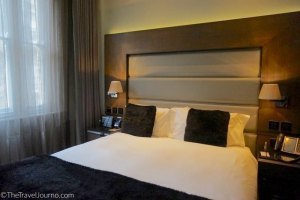
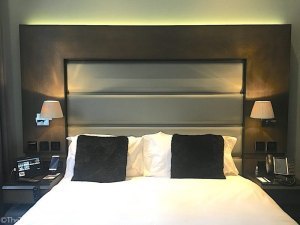



My favourite part, style-wise, was the bathroom – a sleek, white marble space where you’ll find a huge two-person shower cubicle fitted with four (yes FOUR) showers. Two rainforest showers were overhead, and an excellent power shower and hand-held shower were fitted to the wall. Eccleston Square Hotel provides various L’Occitane bathroom miniatures (including a lovely Lavender sleep spray) and the whole room was bright and airy, thanks to the natural light that flooded through the frosted floor-to-ceiling windows.
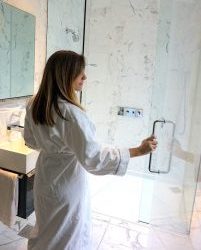
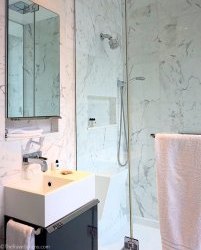
Hi-tech features
The technology at Eccleston Square Hotel is evident as soon as you walk through the traditional front door that’s fitted with automatic sensors. There’s an iPad on the front desk telling you the weather forecast in London and even the lifts are fitted with six miniature TV screens, all tuned into different channels.
Once inside the guest room, all the light fixtures, except for the bedside lamps, are controlled using electronic switches and the heating, curtains and ‘Do Not Disturb’ sign at your door (no need to hang a sign up) are also electronically controlled. There is also, of course, free wifi.

On the bedside table, you’ll find an iPad that’s been installed with a variety of features that are particularly useful for first-time visitors to London. There’s a catalogue of restaurants to try in the area, a list of local attractions (you’ll also find tips for things to do on the Eccleston Square Hotel blog) and a delivery-app called Night Room Service, offering food delivery from around 50 London restaurants, which is great if you fancy eating in. There’s the option for in-room dining from the hotel’s in-house chefs and the local restaurant Lobster & More will also deliver a wide range of dishes to the hotel. For a fee, the in-room iPad also offers the option of late check-out (which we took advantage of) – very handy indeed.
One of the most noteworthy features for foreign travellers is the smartphone which every guest has in their room. You can take it out with you, use the social media and make use of the unlimited data – you can even make international calls to selected countries. It wasn’t something I needed but if you’re travelling from overseas, this is a great added extra.
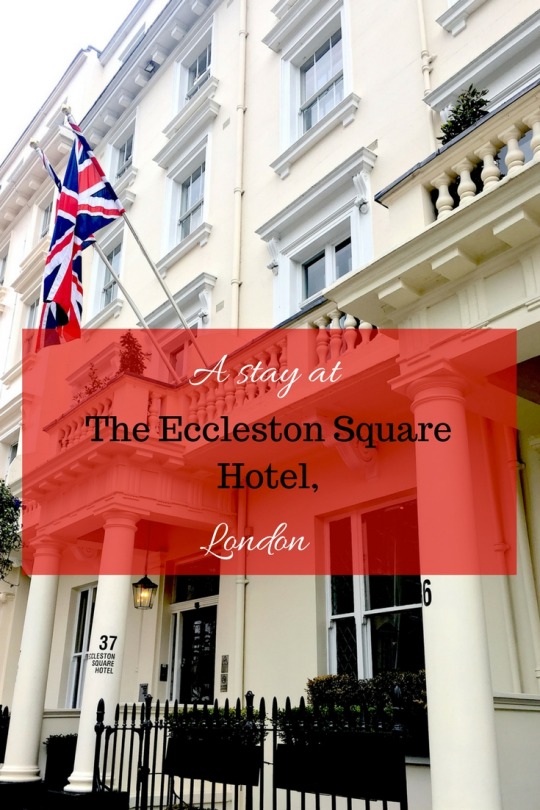
The massage bed
The feature I’d been looking forward to the most was the Hästens massage bed. After an afternoon walk in the area, I enjoyed a bit of down time ahead of us going out for dinner (I’m pregnant, I have an excuse) so it was the perfect time to try it out.
If you haven’t heard of them, Hästens beds are pretty highly sought-after. Hand-made in Sweden, they cost upwards of £12,000 each and are crafted using sustainable materials such as pure flax and hypoallergenic horsehair, which are said to channel away moisture and excess heat and lead to a better night’s sleep. (I can back that up, I slept very well).
When it comes to the massage function, I have to admit, the massage beds were quite loud and provided a strong vibration rather than a kneading motion (which is what I was expecting) to your body or feet area. That said, I liked the way you could raise the head and feet to your preferred position – a great way to watch the 46-inch TV in comfort.
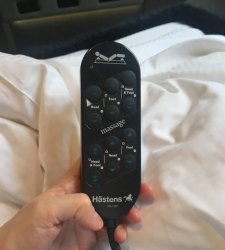
Speaking of TVs, there were two screens in our hotel room – one at the end of your bed, and a small one fitted inside the bathroom which syncs to whatever you’re watching in the main bedroom.
I’m not sure if it’s the case in every guestroom, but our bathroom TV was located opposite the toilet and you could just about see it from the shower. It’s great if you want to listen to a music channel, but personally, I’d have loved to see a bathtub in there, so you could enjoy a long soak with your favourite programme in front of you.
I think you’ll agree, it’s a pretty cool feature nonetheless. And we got a surprise when we discovered that the bathroom door can switch between frosted and transparent, again, at the touch of a button. The last time I saw this was at a hotel in Kuala Lumpur – another feature that technology geeks will no doubt love.
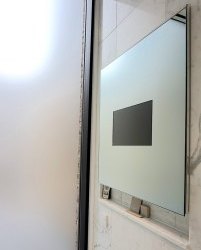
3D movies
The final hi-tech feature you’ll want to check out is the option to watch 3D movies which are all complimentary with your stay. In keeping with their convenient ordering system, guests can pick from a selection of 3D Blu-ray movie options on the iPad and within minutes, a member of staff will arrive at your door with the DVD and Panasonic 3D glasses.
PJs on and massage bed set at the perfect incline, we were ready for our 3D experience, but sadly, neither of the movies could be supported as it turned out, the TV needed an upgrade. It wasn’t something the staff could fix at the time and they were incredibly apologetic; however, after all the hype, we were gutted we couldn’t experience it!
Downstairs in the hotel, next to the bar, they do have a ‘media room’ where guests have the option to watch movies on the 103-inch LED TV. We were already in our PJs at this point so didn’t fancy coming back downstairs, however it’s a great option for watching sport if you know it’s going to be available. You can also sync your laptop to the screen, so it’s well set up for events and private meetings.

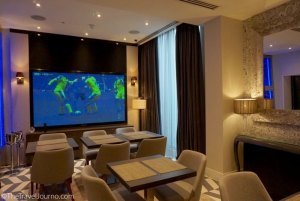
Food and Drink at Eccleston Square Hotel
Once you check out the in-room iPad at the Eccleston Square Hotel, as mentioned, you’ll see that you can order a number of food options to your room, or in the dining area downstairs.
We went out for dinner in Victoria, however, we did order from the hotel breakfast menu the next morning. The Eggs Benedict and Eggs Royale were both delicious even though my request for the sauce to be served ‘on the side’ wasn’t noted. The fresh fruit with yoghurt was also fantastic with thick gooey yoghurt, fresh mint and a drizzle of honey. It all arrived fairly promptly and was a great way to end a lovely London stay.
I’ll also be writing a separate post about the afternoon tea at Eccleston Square Hotel, very soon.
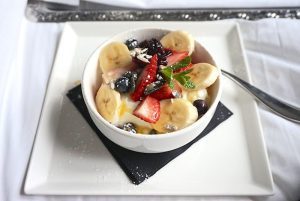


Verdict
Although we felt this hotel didn’t quite hit the mark in some areas, the service was extremely warm and welcoming, the room was super clean and cosy, and we felt it had lots of brilliant features that made for a comfortable stay. If you’re looking for something super luxurious, do check out their new townhouses which recently opened. However, I would recommend the Eccleston Square Hotel for couples enjoying a weekend away in London and anyone looking for a personalised stay with excellent access to central London and all its attractions.
It’s not often you can enjoy a free mini-bar, 24-hour tea service and an array of services which you can conveniently order from a screen. With rooms starting from just £125, this boutique hotel gets a thumbs up for convenience, value-for-money and style.
For more information, visit the Eccleston Square Hotel website and follow them on Instagram, twitter and Facebook.
Have you been to Eccleston Square Hotel? Feel free to leave a comment and share your travel tips and thoughts.
Eccleston Square Hotel, 37 Eccleston Square, London SW1V 1PB, 020 8068 1011
Pin Me
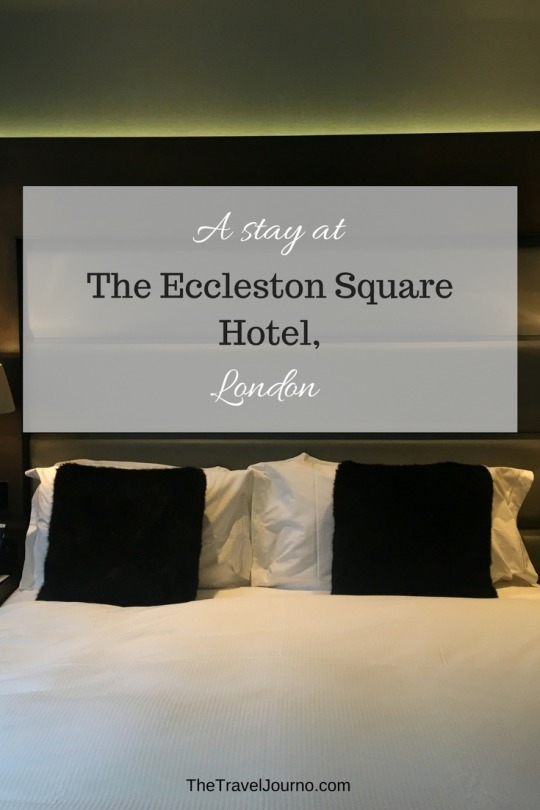
Like this:
Like Loading…
Our stay at Eccleston Square Hotel was complimentary. All views here are my own.
source http://cheaprtravels.com/a-stay-at-the-eccleston-square-hotel-in-belgravia-2/
1 note
·
View note
Text
A Stay at The Eccleston Square Hotel in Belgravia
If you have a penchant for personalised, boutique hotels, you might like to check out the Eccleston Square Hotel. This family-run hotel located in SW1 opened in 2011 when Olivia Byrne decided to create one of the most ‘technologically advanced hotels’ in London. At 23, the Paris-born entrepreneur was dubbed one of the youngest hoteliers of the time.
Since then, the 4.5-star hotel has picked up quite a few accolades. Conde Nast Traveler listed it in the top 15 best boutique hotels in London and it picked up their Reader’s Choice Award in 2016. You’ll also find many articles applauding the hotel’s various hi-tech features and massage beds that come with every room.
With no plans to travel far over the Easter weekend, BC and I took up the opportunity to enjoy a one-night stay here and make the most of some ‘London time’ following our recent move. Here’s how it went.
Eccleston Square Hotel: The Location
The location of Eccleston Square Hotel is definitely one of its strengths. Eccleston Square is located in the SW1V area of London. And overlooking a leafy garden, it feels surprisingly quiet, but is actually, very accessible. Victoria coach, railway and tube stations are just a five-minute walk away. And you have Pimlico, Belgravia and the attractions of Westminster right on your doorstep. It’s a great location for anyone visiting the theatres in Victoria too.
The building itself is a Grade II listed Georgian townhouse, which is immediately appealing for travellers who appreciate a bit of character, although, as you’ll read below, this is a super modern hotel inside.
Interestingly, you’ll find the house that Winston Churchill lived in, just a few doors down and I’m told that Queen Victoria’s granddaughter once lived in the building that is now the hotel.
How’s that for a bit of history?
The Arrival
It was very quiet when we first arrived, and we waited a few minutes at reception for someone to greet us. Once they did, the front-of-house staff were very warm and friendly, and check-in was quick and seamless. They’ve taken a very contemporary approach at the Eccleston Square Hotel, with lots of monochrome, marble and sparkling chandeliers.

Once we’d checked in, one of the hotel staff took us up to our room on the first floor and gave us a thorough explanation of the technology and services in the room, which was a nice touch.
The hotel entrance hall
The entrance to our guest room at the Eccleston Square Hotel
The guestroom interiors & amenities
The guestroom interiors, much like the hotel reception, are contemporary and quite business-like with dark wooden wardrobes and furniture, grey carpets and black faux-fur cushions and throws.
There are two fluffy towelling robes and slippers in the wardrobe and guests who have booked directly through the hotel can enjoy a complimentary mini-bar (choice of Evian water, two types of beer and soft drinks). There’s also a Nespresso coffee machine and while there’s no kettle, they do offer a free 24-hour tea service – something I think every hotel should adopt!





My favourite part, style-wise, was the bathroom – a sleek, white marble space where you’ll find a huge two-person shower cubicle fitted with four (yes FOUR) showers. Two rainforest showers were overhead, and an excellent power shower and hand-held shower were fitted to the wall. Eccleston Square Hotel provides various L’Occitane bathroom miniatures (including a lovely Lavender sleep spray) and the whole room was bright and airy, thanks to the natural light that flooded through the frosted floor-to-ceiling windows.
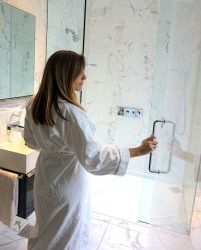
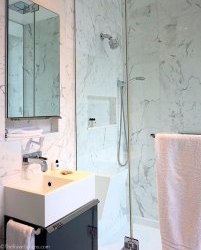
Hi-tech features
The technology at Eccleston Square Hotel is evident as soon as you walk through the traditional front door that’s fitted with automatic sensors. There’s an iPad on the front desk telling you the weather forecast in London and even the lifts are fitted with six miniature TV screens, all tuned into different channels.
Once inside the guest room, all the light fixtures, except for the bedside lamps, are controlled using electronic switches and the heating, curtains and ‘Do Not Disturb’ sign at your door (no need to hang a sign up) are also electronically controlled. There is also, of course, free wifi.

On the bedside table, you’ll find an iPad that’s been installed with a variety of features that are particularly useful for first-time visitors to London. There’s a catalogue of restaurants to try in the area, a list of local attractions (you’ll also find tips for things to do on the Eccleston Square Hotel blog) and a delivery-app called Night Room Service, offering food delivery from around 50 London restaurants, which is great if you fancy eating in. There’s the option for in-room dining from the hotel’s in-house chefs and the local restaurant Lobster & More will also deliver a wide range of dishes to the hotel. For a fee, the in-room iPad also offers the option of late check-out (which we took advantage of) – very handy indeed.
One of the most noteworthy features for foreign travellers is the smartphone which every guest has in their room. You can take it out with you, use the social media and make use of the unlimited data – you can even make international calls to selected countries. It wasn’t something I needed but if you’re travelling from overseas, this is a great added extra.

The massage bed
The feature I’d been looking forward to the most was the Hästens massage bed. After an afternoon walk in the area, I enjoyed a bit of down time ahead of us going out for dinner (I’m pregnant, I have an excuse) so it was the perfect time to try it out.
If you haven’t heard of them, Hästens beds are pretty highly sought-after. Hand-made in Sweden, they cost upwards of £12,000 each and are crafted using sustainable materials such as pure flax and hypoallergenic horsehair, which are said to channel away moisture and excess heat and lead to a better night’s sleep. (I can back that up, I slept very well).
When it comes to the massage function, I have to admit, the massage beds were quite loud and provided a strong vibration rather than a kneading motion (which is what I was expecting) to your body or feet area. That said, I liked the way you could raise the head and feet to your preferred position – a great way to watch the 46-inch TV in comfort.
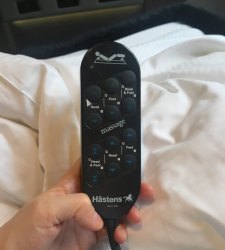
Speaking of TVs, there were two screens in our hotel room – one at the end of your bed, and a small one fitted inside the bathroom which syncs to whatever you’re watching in the main bedroom.
I’m not sure if it’s the case in every guestroom, but our bathroom TV was located opposite the toilet and you could just about see it from the shower. It’s great if you want to listen to a music channel, but personally, I’d have loved to see a bathtub in there, so you could enjoy a long soak with your favourite programme in front of you.
I think you’ll agree, it’s a pretty cool feature nonetheless. And we got a surprise when we discovered that the bathroom door can switch between frosted and transparent, again, at the touch of a button. The last time I saw this was at a hotel in Kuala Lumpur – another feature that technology geeks will no doubt love.

3D movies
The final hi-tech feature you’ll want to check out is the option to watch 3D movies which are all complimentary with your stay. In keeping with their convenient ordering system, guests can pick from a selection of 3D Blu-ray movie options on the iPad and within minutes, a member of staff will arrive at your door with the DVD and Panasonic 3D glasses.
PJs on and massage bed set at the perfect incline, we were ready for our 3D experience, but sadly, neither of the movies could be supported as it turned out, the TV needed an upgrade. It wasn’t something the staff could fix at the time and they were incredibly apologetic; however, after all the hype, we were gutted we couldn’t experience it!
Downstairs in the hotel, next to the bar, they do have a ‘media room’ where guests have the option to watch movies on the 103-inch LED TV. We were already in our PJs at this point so didn’t fancy coming back downstairs, however it’s a great option for watching sport if you know it’s going to be available. You can also sync your laptop to the screen, so it’s well set up for events and private meetings.

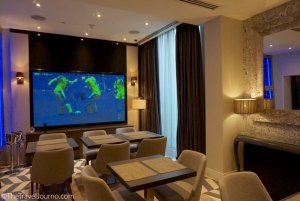
Food and Drink at Eccleston Square Hotel
Once you check out the in-room iPad at the Eccleston Square Hotel, as mentioned, you’ll see that you can order a number of food options to your room, or in the dining area downstairs.
We went out for dinner in Victoria, however, we did order from the hotel breakfast menu the next morning. The Eggs Benedict and Eggs Royale were both delicious even though my request for the sauce to be served ‘on the side’ wasn’t noted. The fresh fruit with yoghurt was also fantastic with thick gooey yoghurt, fresh mint and a drizzle of honey. It all arrived fairly promptly and was a great way to end a lovely London stay.
I’ll also be writing a separate post about the afternoon tea at Eccleston Square Hotel, very soon.

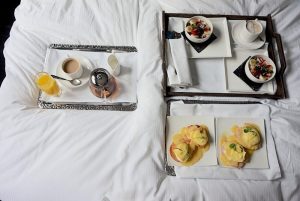

Verdict
Although we felt this hotel didn’t quite hit the mark in some areas, the service was extremely warm and welcoming, the room was super clean and cosy, and we felt it had lots of brilliant features that made for a comfortable stay. If you’re looking for something super luxurious, do check out their new townhouses which recently opened. However, I would recommend the Eccleston Square Hotel for couples enjoying a weekend away in London and anyone looking for a personalised stay with excellent access to central London and all its attractions.
It’s not often you can enjoy a free mini-bar, 24-hour tea service and an array of services which you can conveniently order from a screen. With rooms starting from just £125, this boutique hotel gets a thumbs up for convenience, value-for-money and style.
For more information, visit the Eccleston Square Hotel website and follow them on Instagram, twitter and Facebook.
Have you been to Eccleston Square Hotel? Feel free to leave a comment and share your travel tips and thoughts.
Eccleston Square Hotel, 37 Eccleston Square, London SW1V 1PB, 020 8068 1011
Pin Me

Like this:
Like Loading…
Our stay at Eccleston Square Hotel was complimentary. All views here are my own.
from Cheapr Travels http://cheaprtravels.com/a-stay-at-the-eccleston-square-hotel-in-belgravia-2/
via http://cheaprtravels.com
0 notes
Text
A Stay at The Eccleston Square Hotel in Belgravia
If you have a penchant for personalised, boutique hotels, you might like to check out the Eccleston Square Hotel. This family-run hotel located in SW1 opened in 2011 when Olivia Byrne decided to create one of the most ‘technologically advanced hotels’ in London. At 23, the Paris-born entrepreneur was dubbed one of the youngest hoteliers of the time.
Since then, the 4.5-star hotel has picked up quite a few accolades. Conde Nast Traveler listed it in the top 15 best boutique hotels in London and it picked up their Reader’s Choice Award in 2016. You’ll also find many articles applauding the hotel’s various hi-tech features and massage beds that come with every room.
With no plans to travel far over the Easter weekend, BC and I took up the opportunity to enjoy a one-night stay here and make the most of some ‘London time’ following our recent move. Here’s how it went.
Eccleston Square Hotel: The Location
The location of Eccleston Square Hotel is definitely one of its strengths. Eccleston Square is located in the SW1V area of London. And overlooking a leafy garden, it feels surprisingly quiet, but is actually, very accessible. Victoria coach, railway and tube stations are just a five-minute walk away. And you have Pimlico, Belgravia and the attractions of Westminster right on your doorstep. It’s a great location for anyone visiting the theatres in Victoria too.
The building itself is a Grade II listed Georgian townhouse, which is immediately appealing for travellers who appreciate a bit of character, although, as you’ll read below, this is a super modern hotel inside.
Interestingly, you’ll find the house that Winston Churchill lived in, just a few doors down and I’m told that Queen Victoria’s granddaughter once lived in the building that is now the hotel.
How’s that for a bit of history?
The Arrival
It was very quiet when we first arrived, and we waited a few minutes at reception for someone to greet us. Once they did, the front-of-house staff were very warm and friendly, and check-in was quick and seamless. They’ve taken a very contemporary approach at the Eccleston Square Hotel, with lots of monochrome, marble and sparkling chandeliers.

Once we’d checked in, one of the hotel staff took us up to our room on the first floor and gave us a thorough explanation of the technology and services in the room, which was a nice touch.
The hotel entrance hall
The entrance to our guest room at the Eccleston Square Hotel
The guestroom interiors & amenities
The guestroom interiors, much like the hotel reception, are contemporary and quite business-like with dark wooden wardrobes and furniture, grey carpets and black faux-fur cushions and throws.
There are two fluffy towelling robes and slippers in the wardrobe and guests who have booked directly through the hotel can enjoy a complimentary mini-bar (choice of Evian water, two types of beer and soft drinks). There’s also a Nespresso coffee machine and while there’s no kettle, they do offer a free 24-hour tea service – something I think every hotel should adopt!



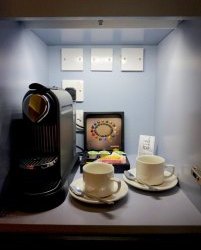

My favourite part, style-wise, was the bathroom – a sleek, white marble space where you’ll find a huge two-person shower cubicle fitted with four (yes FOUR) showers. Two rainforest showers were overhead, and an excellent power shower and hand-held shower were fitted to the wall. Eccleston Square Hotel provides various L’Occitane bathroom miniatures (including a lovely Lavender sleep spray) and the whole room was bright and airy, thanks to the natural light that flooded through the frosted floor-to-ceiling windows.


Hi-tech features
The technology at Eccleston Square Hotel is evident as soon as you walk through the traditional front door that’s fitted with automatic sensors. There’s an iPad on the front desk telling you the weather forecast in London and even the lifts are fitted with six miniature TV screens, all tuned into different channels.
Once inside the guest room, all the light fixtures, except for the bedside lamps, are controlled using electronic switches and the heating, curtains and ‘Do Not Disturb’ sign at your door (no need to hang a sign up) are also electronically controlled. There is also, of course, free wifi.

On the bedside table, you’ll find an iPad that’s been installed with a variety of features that are particularly useful for first-time visitors to London. There’s a catalogue of restaurants to try in the area, a list of local attractions (you’ll also find tips for things to do on the Eccleston Square Hotel blog) and a delivery-app called Night Room Service, offering food delivery from around 50 London restaurants, which is great if you fancy eating in. There’s the option for in-room dining from the hotel’s in-house chefs and the local restaurant Lobster & More will also deliver a wide range of dishes to the hotel. For a fee, the in-room iPad also offers the option of late check-out (which we took advantage of) – very handy indeed.
One of the most noteworthy features for foreign travellers is the smartphone which every guest has in their room. You can take it out with you, use the social media and make use of the unlimited data – you can even make international calls to selected countries. It wasn’t something I needed but if you’re travelling from overseas, this is a great added extra.
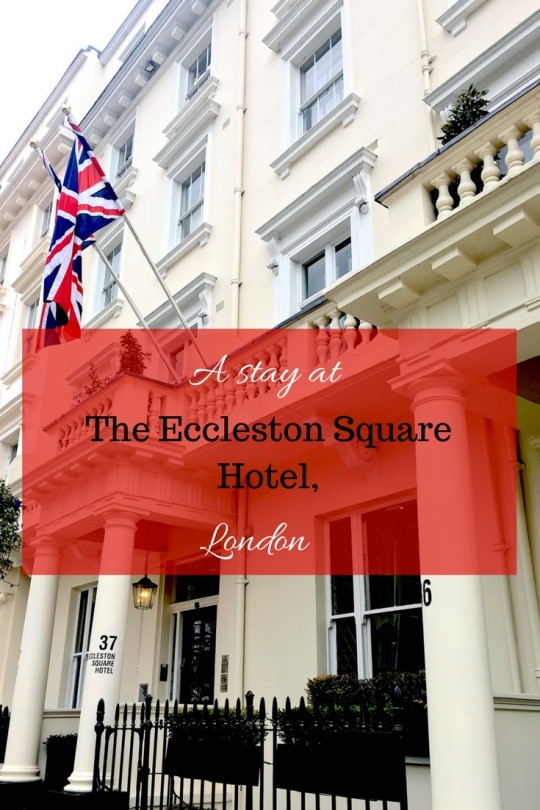
The massage bed
The feature I’d been looking forward to the most was the Hästens massage bed. After an afternoon walk in the area, I enjoyed a bit of down time ahead of us going out for dinner (I’m pregnant, I have an excuse) so it was the perfect time to try it out.
If you haven’t heard of them, Hästens beds are pretty highly sought-after. Hand-made in Sweden, they cost upwards of £12,000 each and are crafted using sustainable materials such as pure flax and hypoallergenic horsehair, which are said to channel away moisture and excess heat and lead to a better night’s sleep. (I can back that up, I slept very well).
When it comes to the massage function, I have to admit, the massage beds were quite loud and provided a strong vibration rather than a kneading motion (which is what I was expecting) to your body or feet area. That said, I liked the way you could raise the head and feet to your preferred position – a great way to watch the 46-inch TV in comfort.
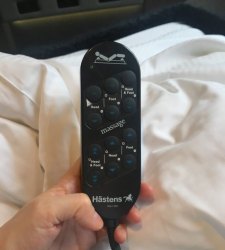
Speaking of TVs, there were two screens in our hotel room – one at the end of your bed, and a small one fitted inside the bathroom which syncs to whatever you’re watching in the main bedroom.
I’m not sure if it’s the case in every guestroom, but our bathroom TV was located opposite the toilet and you could just about see it from the shower. It’s great if you want to listen to a music channel, but personally, I’d have loved to see a bathtub in there, so you could enjoy a long soak with your favourite programme in front of you.
I think you’ll agree, it’s a pretty cool feature nonetheless. And we got a surprise when we discovered that the bathroom door can switch between frosted and transparent, again, at the touch of a button. The last time I saw this was at a hotel in Kuala Lumpur – another feature that technology geeks will no doubt love.
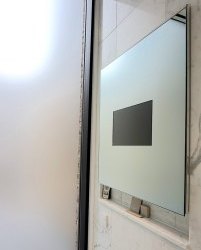
3D movies
The final hi-tech feature you’ll want to check out is the option to watch 3D movies which are all complimentary with your stay. In keeping with their convenient ordering system, guests can pick from a selection of 3D Blu-ray movie options on the iPad and within minutes, a member of staff will arrive at your door with the DVD and Panasonic 3D glasses.
PJs on and massage bed set at the perfect incline, we were ready for our 3D experience, but sadly, neither of the movies could be supported as it turned out, the TV needed an upgrade. It wasn’t something the staff could fix at the time and they were incredibly apologetic; however, after all the hype, we were gutted we couldn’t experience it!
Downstairs in the hotel, next to the bar, they do have a ‘media room’ where guests have the option to watch movies on the 103-inch LED TV. We were already in our PJs at this point so didn’t fancy coming back downstairs, however it’s a great option for watching sport if you know it’s going to be available. You can also sync your laptop to the screen, so it’s well set up for events and private meetings.


Food and Drink at Eccleston Square Hotel
Once you check out the in-room iPad at the Eccleston Square Hotel, as mentioned, you’ll see that you can order a number of food options to your room, or in the dining area downstairs.
We went out for dinner in Victoria, however, we did order from the hotel breakfast menu the next morning. The Eggs Benedict and Eggs Royale were both delicious even though my request for the sauce to be served ‘on the side’ wasn’t noted. The fresh fruit with yoghurt was also fantastic with thick gooey yoghurt, fresh mint and a drizzle of honey. It all arrived fairly promptly and was a great way to end a lovely London stay.
I’ll also be writing a separate post about the afternoon tea at Eccleston Square Hotel, very soon.



Verdict
Although we felt this hotel didn’t quite hit the mark in some areas, the service was extremely warm and welcoming, the room was super clean and cosy, and we felt it had lots of brilliant features that made for a comfortable stay. If you’re looking for something super luxurious, do check out their new townhouses which recently opened. However, I would recommend the Eccleston Square Hotel for couples enjoying a weekend away in London and anyone looking for a personalised stay with excellent access to central London and all its attractions.
It’s not often you can enjoy a free mini-bar, 24-hour tea service and an array of services which you can conveniently order from a screen. With rooms starting from just £125, this boutique hotel gets a thumbs up for convenience, value-for-money and style.
For more information, visit the Eccleston Square Hotel website and follow them on Instagram, twitter and Facebook.
Have you been to Eccleston Square Hotel? Feel free to leave a comment and share your travel tips and thoughts.
Eccleston Square Hotel, 37 Eccleston Square, London SW1V 1PB, 020 8068 1011
Pin Me
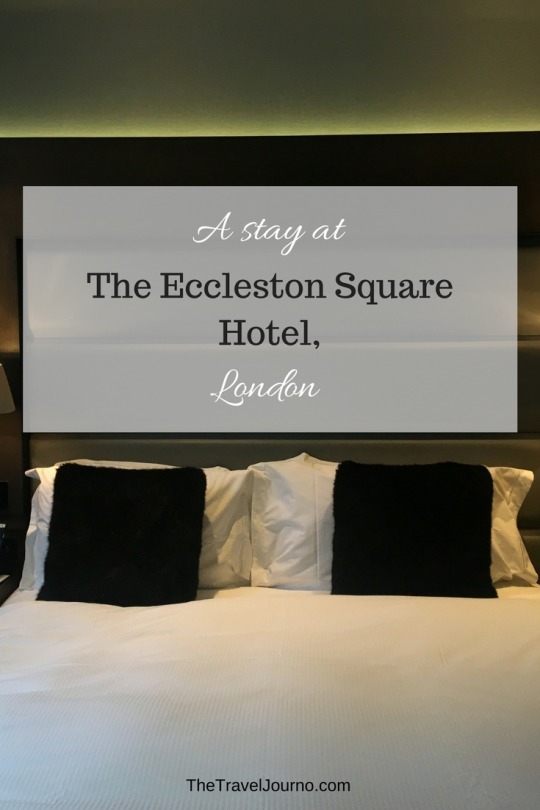
Like this:
Like Loading…
Our stay at Eccleston Square Hotel was complimentary. All views here are my own.
from Cheapr Travels http://cheaprtravels.com/a-stay-at-the-eccleston-square-hotel-in-belgravia-2/
via IFTTT
0 notes
Text
How to climb Aconcagua: all your questions answered
Our Q&A-style tips on how to climb Aconcagua, assembled from the many questions asked by our followers
I didn’t announce I was climbing Aconcagua on social media until the day I left for Argentina. It was part superstition (I didn’t want to jinx the climb), but more importantly, I knew that I was about to embark on the hardest and highest climb of my life.
It was a very real possibility that I would not make the summit. Weather, altitude and exhaustion all stood in the way of success. I didn’t want to make a big deal about it only to later admit that I failed.
As such, I only sent one or two brief updates when I arrived in Mendoza and then went silent once I began the climb.
youtube
When it was all over and I was back in civilisation, I announced the climb across our social channels, first with my summit photo and then a volley of updates from the previous two weeks of trekking and climbing.
I was immediately inundated with congratulatory messages, followed by a barrage of questions about the experience via email and social media.
I’ve collated them all below in a detailed Q&A that includes all my tips on how to climb Aconcagua.
How high is Aconcagua?
The majority of literature on Aconcagua puts the height at 6,962m (22,840ft). This is based on a 2001 survey by an Italian-Argentinian team that put the mountain at 6,961.83m.
However, in 2012, a team of scientists from various academic institutions in Mendoza re-surveyed Aconcagua and came up with 6,960.8m (6,981m/22,837ft). Even though this is the most recent measurement, it is not widely used.
Did you climb Aconcagua with a guide?
Yes, I joined Acomara Aconcagua Expeditions on a guided climb via the ‘Normal Route’. Acomara has over 15 years of experience guiding on and climbing Aconcagua across more than 500 expeditions.
Can you climb Aconcagua unguided?
You can climb Aconcagua without a guide, but the vast majority of climbers do use guides. It significantly increases your chances of success. During the expedition, I met just three climbers who weren’t using guides. None of them summited.
Those who do climb independently will almost certainly make use of some of the logistical support at Confluencia and Plaza de Mulas camps. This may include porterage, food, accommodation and toilets.
How big was your group?
There were 12 climbers in our group. I climbed during the busiest time of the season (mid-December through January) so our group was full. We had two lead guides and then two assistant guides for the higher camps and summit day.
How many of your group made the summit?
Seven members of our team made the summit. One member was carrying an ongoing knee injury and had to descend from base camp. Another four members turned back on summit day.
Atlas & Boots On the summit of Aconcagua
What is the summit success rate on Aconcagua?
There are no official statistics and park rangers do not maintain records, but estimates suggest a summit success rate of around 30-40% historically.
However, this has improved in recent years. Our freelance guides suggested that it is higher these days with around 70% of their clients reaching the summit. Overall, Acomara has an 80% summit success rate over the 15 years they’ve been guiding on Aconcagua.
Of our group, 58.3% (7/12) summited. It’s important that clients ensure they are fit and experienced before attempting this climb.
How long does it take to climb Aconcagua?
My itinerary was 18 days which included 14 days of climbing, a night at each end of the trip in Mendoza, one night in Los Penitentes and two additional days built in as reserves in case of bad weather.
The itinerary is below, although it comes with a degree of flexibility depending on conditions on the mountain. It includes two dedicated acclimatisation hikes and three rest days.
Day From/to Duration Altitude 1 Meet in Mendoza N/A 750m 2 Transfer to Penitentes 3 hours 2,725m 3 Trek to Confluencia Camp 3 hours 3,400m 4 Acclimatisation hike to Plaza Francia 7-8 hours 4,000m 5 Trek to base camp: Plaza de Mulas 8-9 hours 4,300m 6 Rest day at base camp: Plaza de Mulas N/A 4,300m 7 Acclimatisation hike to Mt. Bonete 7-9 hours 5,000m 8 Carry to Camp 1: Canadá, return to base camp 4-6 hours 4,900m 9 Rest day at base camp: Plaza de Mulas N/A 4,300m 10 Climb to Camp 1: Canadá 3-4 hours 4,900m 11 Climb and carry to Camp 2: Nido de Cóndores 3-4 hours 5,560m 12 Rest day at Camp 2: Nido de Cóndores N/A 5,560m 13 Climb and carry to Camp 3: Cólera 3-4 hours 6,000m 14 Summit day and return to Camp 3: Cólera 12-15 hours 6,961m 15 Descend to base camp: Plaza de Mulas 4-6 hours 4,300m 16 Trek out to Laguna de Horcones 7-9 hours 2,900m 17-18 Reserve days for summit N/A N/A
It should also be noted that if the itinerary changes for any reason, then additional accommodation is not provided. We summited a day earlier than planned and financed the extra nights in the hotel in Mendoza at around $65 USD per night.
How much does it cost to climb Aconcagua?
Prices start from around $4,000 USD depending on dates and the itinerary for a round trip from Mendoza. The price includes all accommodation, meals on the trek, English-speaking guides and assistants, and porters to carry equipment between camps and ground transport.
There is also the climbing permit which currently costs between $730-$1,140 USD depending on the route and time of year. The current price list can be downloaded from the park’s website.
Including the cost of the permit, flights and additional accommodation, climbers should budget to spend upwards of $6,000 USD.
How hard is the climb?
Aconcagua is an extremely challenging mountain. I’ve said before and I’ll say it again: it was the highest and hardest climb I’ve completed. I would not recommend this as a first high-altitude trek or climb.
The main challenges are the altitude and the weather, both of which are amplified by the relative distance of Aconcagua from the equator. The further you travel from the equator, the thinner the Earth’s atmosphere becomes. As such, the effects of altitude are more extreme and the weather is more volatile.
Temperatures are severe, regularly dropping below -20°C (-4°F). The wind (and subsequent windchill) is relentless and even on the best days, the slopes are bleak, barren and harsh.
Underestimate Aconcagua at your peril. Many do and, as such, repeat visits are common.
Atlas & Boots A typical view from the slopes of Aconcagua
Do I need technical mountaineering skills?
The one saving grace is that Aconcagua does not require any specialist mountaineering skills. It is often referred to as the highest trekking peak in the world.
Climbers will need to wear plastic boots and (probably) crampons and occasionally use an ice axe, but Aconcagua is essentially a non-technical mountain. Any experience of these will be useful.
How does it compare to the other seven summits?
Aconcagua is South America’s highest mountain and one of the seven summits: the seven peaks coveted by climbers who want to reach the highest point on every continent.
It was my third mountain of the seven after Elbrus in Russia and Kilimanjaro in Tanzania and is significantly harder than both.
It is difficult to draw comparisons, but Aconcagua is generally considered to be the second hardest of the seven summits after Everest. This is largely down to its height and the challenges of climbing at such altitude.
Seven summiteer Alan Arnette suggests that Aconcagua has the lowest summit success rate of all the seven mountains – even lower than Everest in the modern era. That said, all the mountains have different challenges.
Denali in North America is known for the cold, Vinson in Antarctica is notoriously inaccessible, Puncak Jaya in Oceania is the most technical and Everest is the highest mountain on the planet.
Summit Continent Altitude Technical difficulty Mount Everest Asia 8,848m (29,029ft) Intermediate Aconcagua South America 6,961m (22,838ft) Easy Denali North America 6,194m (20,322ft) Intermediate Kilimanjaro Africa 5,895m (19,341ft) Easy Mount Elbrus Europe 5,642m (18,510ft) Easy Mount Vinson Antarctica 4,892m (16,050ft) Intermediate Puncak Jaya Oceania 4,884m (16,024ft) Advanced
How did you train for the climb?
I spent most of 2019 preparing for Aconcagua. I upped my gym routine significantly. I spent a lot of time working on cardio (running and swimming) for high-altitude performance. I also worked on my upper body, focusing on my core muscles to improve strength for carrying a backpack.
I went on several long-distance and high-altitude treks in the preceding 12 months. These included the Everest base camp trek in Nepal, the K2 base camp trek in Pakistan and the Arctic Circle Trail in Greenland.
Additionally, I went on numerous local day hikes and multi-day treks carrying over 20kg (44lb) on my back.
What was the hardest part?
The devilish Canaleta scree slope at around 6,700m (21,981ft) on summit day is utterly soul-destroying. The mixture of loose gravel and rocks means for every two steps forward you slide back one. It takes several hours of slipping, sliding and swearing to ascend.
How cold does it get? What is the weather like?
The most predictable feature of the weather on Aconcagua is its unpredictability. Temperatures regularly drop below -20°C (-4°F), but climbers should be prepared for temperatures as low as -30°C (-22°F), particularly at night.
During the day it is often sunny, but no matter how strong the sun and clear the sky, the infamous Aconcagua wind and the hostile chill that accompanies it is never far away. The wind chill factor of Aconcagua is extreme; it can lower temperatures by as much as 15°C (59°F).
It snowed several times during our climb, most heavily on summit day when we had a whiteout. You should be prepared for the same.
When is the best time to climb Aconcagua?
The best time for climbing Aconcagua is from mid-December to the end of January. The climbing season runs from mid-November to the end of March, but the weather is more changeable earlier and later in the season.
Even at the best of times, climbers should be prepared for high winds, snow, ice and low temperatures.
What should I pack?
I’ve put together a detailed Aconcagua gear list. It contains everything I took with me including clothing, equipment, toiletries, medication, electronics and documentation.
Atlas & Boots How to climb Aconcagua? Start with the right gear!
Can I buy/hire trekking gear and clothes locally?
It is possible to rent most items on arrival in Mendoza. However, it’s cheaper in the long run to buy your own gear and it’s also better to have tested everything beforehand, particularly when it comes to footwear and clothing.
Mendoza has several outdoor stores where it’s possible to buy gear. But be warned: outdoor gear is very expensive in Argentina. It’s almost certainly cheaper to buy gear in your home country.
If you’re travelling in South America beforehand, then Chile is a good destination to buy outdoor equipment. My guides told me they take a bus across the border to Santiago to buy theirs.
What is base camp like?
Plaza de Mulas base camp is best described as a sprawling tent town. It houses hundreds of climbers and trekkers and the guides, cooks and porters who assist them up the mountain. Most outfits have a central dome tent for meals and a support tent for cooking surrounded by dozens of tents for their staff and clients.
I was surprised at the size of base camp and the extent of its services. It’s possible to buy drinks (alcoholic and soft), food, cigarettes, hire porters and guides and even visit an art gallery.
Atlas & Boots Looking across base camp towards the glacier
Is there an Aconcagua base camp trek I can do instead?
Yes. We were joined by a trekker who hiked with us to base camp and accompanied the climbing team on the acclimatisation hikes to Plaza Francia and Mt. Bonete.
He was planning to attempt Aconcagua the following year and wanted to gain some high-altitude experience first. Acomara offer several trekking options.
How many camps are there?
There are five camps in total:
Confluencia: 3,400m, 2 nights
Base camp (Plaza de Mulas): 4,300m, 6 nights
Camp 1 (Canadá): 4,950m, 1 night
Camp 2 (Nido de Cóndores): 5,560m, 2 nights
Camp 3 (Cólera): 6,000m, 2-3 nights
What time did you get up on summit day?
We woke up at 3am on summit day and left camp at 4.30am. It took us eight hours to reach the summit and four hours to descend.
Summit days regularly last as long as 15 hours, sometimes longer.
Where do you get drinking water?
At Confluencia and base camp, water is supplied by the support team. Pipes run from streams flowing from the glacier. The water is stored in barrels for climbers to help themselves to.
Further up the mountain, guides and climbers have to source their water from the snow by melting it themselves.
At Camp 2, we received reports from Camp 3 that there was little snow above, so each team member transported seven litres of water up to Camp 3 from Camp 2 for cooking our meals and drinking on summit day.
What is the food like?
The food was excellent considering where we were. At Confluencia and base camp, mealtimes were sit-down affairs with great variation.
Typically, breakfast was eggs, bread, biscuits and sausages. Lunchboxes were prepared for us for during the day, usually consisting of a sandwich, chocolate and cereal bars and a piece of fruit. Evening meals always included soup followed by something like lasagna, pasta, noodles, pizza and sometimes even a barbecue.
At the higher camps, food became more basic consisting of bread and cheese for breakfast, comparable lunches and evening meals were usually pre-prepared trekking (dehydrated) meals.
Whatever was on the menu, we never went hungry.
Atlas & Boots Relaxing during a rest day
Are meals included in the price?
All meals from leaving Mendoza onwards are included in the price. Climbers may wish to take some preferred snacks or energy gels with them, particularly for summit day.
How do you go to the toilet?
Confluencia and Plaze de Mulas have simple drop-toilet facilities, which invariably become pretty disgusting. However, considering the number of people on the mountain, using the mountainside instead is not viable.
At the higher camps, systems may vary but expect a simple toilet tent to be erected with climbers required to do their business in bin liners. Waste is collected and carried off the mountain by porters and mules.
Please do your utmost to leave no trace whatever system is in place.
Can I take a shower during the climb?
At base camp, it’s possible to take gas-heated showers. One free shower is included in the price of the climb. After that, showers cost $15 USD.
Most climbers (including me) took one shower before leaving base camp for the higher camps. It was utterly delightful.
Is there phone signal or wifi available?
Phone reception is available at base camp, Los Penitentes and in Mendoza. But not at Confluencia or the higher camps. It’s possible to buy local SIM cards in Mendoza.
I packed our Keepgo International Wifi Hotspot to access it. The device generates a wifi connection using local 4G mobile networks in over 120 countries. You can get 10% off any Keepgo product using this referral link.
Can I charge electronics during the climb?
It should be possible to charge devices at the mess tent of your outfitter. This can only be done during the day as they are solar-powered. However, charging points are at a premium and take a long time to charge.
I packed a Powergorilla charger and a Falcon 21 foldable solar charger from PowerTraveller and preferred to use these. They were more powerful, more reliable and functioned in cold temperatures.
The Powergorilla can charge devices up to 24Volts (such as a laptop). I used the solar charger most days as it was reliable enough to charge my smaller devices.
Atlas & Boots Charging gadgets at base camp
Are there any medical facilities or checks?
At Confluencia and base camp there are medical tents where every climber must attend a basic medical check. Doctors stationed here measure blood pressure and oxygen saturation. Anyone who fails these tests will not be allowed to climb further.
Additionally, there are helipads at base camp and Camp 2 for evacuations.
Is climbing Aconcagua dangerous?
In a word, yes, but Aconcagua is a relatively safe climb by the standard routes. However, it is a massive mountain and people die on it every year. I witnessed medical evacuations every day of the climb and the first death of the season happened shortly after I left the mountain.
The main hazards are altitude sickness and exhaustion and exposure, although rockfall and avalanche are also dangers.
Do I need specialist insurance?
One of my most important tips on how to climb Aconcagua is to make sure you select a travel insurance policy that has sufficient medical coverage. It must have a minimum coverage of $250,000 USD for repatriation and emergency rescue (including search and rescue) and helicopter evacuation.
I bought mine from TrueTraveller. For Aconcagua you’ll need the Extreme Adventure Pack as it covers trekking over 4,600 metres.
Should I take Diamox?
This is very much down to the individual. I have never taken Diamox, but I have been to high altitudes several times so I know what to expect. I do carry some with me in case I ever feel particularly bad.
The best advice I can give is what my guide gave me on my Everest base camp trek. Have some Diamox with you and take it as soon as you start to feel the pulsing headaches that are synonymous with altitude sickness.
He said it’s good to have some available at the higher altitudes – particularly when you sleep above 5,000m – so you can use it to aid a good night’s sleep.
What maps or guidebooks do I need?
If you are climbing Aconcagua unguided then the more detailed Aconcagua Climbing Map is essential.
Which route did you take? Are there others?
I climbed via the Normal Route. The other popular route is via the Polish Glacier. The Polish Glacier is longer and harder, but more scenic. Both are trekking routes. There are other routes to the summit but they require mountaineering skills and are generally unsupported.
About 54% of climbers ascend the Normal Route, 43% up the Polish Glacier Route and the remaining 3% on other routes.
Do I need a permit?
All climbers require a climbing permit which must be obtained beforehand from the Ministerio de Turismo in Mendoza.
The climbing permit currently costs between $730-$1,140 USD depending on the route and time of year. The most recent price list can be downloaded from the park’s website.
Atlas & Boots On some days you may have to carry as much as 25kg
What will the porters and mules carry for me?
From the park entrance to Plaza de Mulas, mules carry climbers’ heavy duffle bags, which contain the vast majority of their gear. Climbers will only be responsible for carrying their daypacks.
Beyond base camp, the team employs porters to aid with carrying the tents and cooking equipment. However, climbers are responsible for hauling their personal gear and food up to the higher camps.
From base camp to Camp 1, climbers transport their gear and food in two carries of around 12-15kg (26-33lb) at a time.
Carries from Camp 1 to 2 and from Camp 2 to 3 are done in one load (20-25kg/44-55lb).
It is possible to hire porters who will carry up to 20kg (44lb) between the higher camps. These become more expensive the higher you get:
Base camp to Camp 1: $130 USD
Camp 1 to Camp 2: $170 USD
Camp 2 to Camp 3: $260 USD
How much should I tip guides and porters?
Guides and porters on Aconcagua are paid much better than their counterparts in many other parts of the world – Nepal, Pakistan and Tanzania for example – so tips are not expected to make up part of their income.
That said, showing your appreciation in the form of a tip will go a long way. Allow between $100-200 in tips for your guides, assistants and porters.
How many people climb Aconcagua? Is it busy?
Like most mountains, summit statistics are hard to come by. Park rangers do not maintain records, but we do have access to some statistics of how many people enter the park in recent years.
During the 2015/16 season, 5,551 people entered the park between November and March. Previous seasons have seen as many as 7,000. More figures on visitor numbers can be found here.
This area of Argentina enjoys well-established infrastructure and is not what would be described as remote. That said, the mountain is by no means overcrowded and sees a tiny fraction of the visitors the trails around Everest or Annapurna do in Nepal. The main camps are busier of course, but the trails are generally quiet.
How did you get to Mendoza?
I flew to Mendoza via Santiago in Chile from the UK with British Airways and LATAM. It is possible to fly via Buenos Aires in Argentina, but this often involves changing airports. I use Skyscanner to find the best prices.
I had a long stopover in Santiago so took advantage of the Primeclass Pacifico Andes Lounge inside the international terminal – a godsend after the 14-hour flight from London.
The lounge includes a buffet restaurant, hot and cold drinks, shower and washroom facilities and a business area. Prices start at $50 USD for international passengers.
Enjoyed this post? pin it for later…
Have we missed any anything? If you have any of your own questions or suggestions on how to climb Aconcagua, please contact us.
Lead image: Atlas & Boots
source http://cheaprtravels.com/how-to-climb-aconcagua-all-your-questions-answered/
0 notes
Text
How to climb Aconcagua: all your questions answered
Our Q&A-style tips on how to climb Aconcagua, assembled from the many questions asked by our followers
I didn’t announce I was climbing Aconcagua on social media until the day I left for Argentina. It was part superstition (I didn’t want to jinx the climb), but more importantly, I knew that I was about to embark on the hardest and highest climb of my life.
It was a very real possibility that I would not make the summit. Weather, altitude and exhaustion all stood in the way of success. I didn’t want to make a big deal about it only to later admit that I failed.
As such, I only sent one or two brief updates when I arrived in Mendoza and then went silent once I began the climb.
youtube
When it was all over and I was back in civilisation, I announced the climb across our social channels, first with my summit photo and then a volley of updates from the previous two weeks of trekking and climbing.
I was immediately inundated with congratulatory messages, followed by a barrage of questions about the experience via email and social media.
I’ve collated them all below in a detailed Q&A that includes all my tips on how to climb Aconcagua.
How high is Aconcagua?
The majority of literature on Aconcagua puts the height at 6,962m (22,840ft). This is based on a 2001 survey by an Italian-Argentinian team that put the mountain at 6,961.83m.
However, in 2012, a team of scientists from various academic institutions in Mendoza re-surveyed Aconcagua and came up with 6,960.8m (6,981m/22,837ft). Even though this is the most recent measurement, it is not widely used.
Did you climb Aconcagua with a guide?
Yes, I joined Acomara Aconcagua Expeditions on a guided climb via the ‘Normal Route’. Acomara has over 15 years of experience guiding on and climbing Aconcagua across more than 500 expeditions.
Can you climb Aconcagua unguided?
You can climb Aconcagua without a guide, but the vast majority of climbers do use guides. It significantly increases your chances of success. During the expedition, I met just three climbers who weren’t using guides. None of them summited.
Those who do climb independently will almost certainly make use of some of the logistical support at Confluencia and Plaza de Mulas camps. This may include porterage, food, accommodation and toilets.
How big was your group?
There were 12 climbers in our group. I climbed during the busiest time of the season (mid-December through January) so our group was full. We had two lead guides and then two assistant guides for the higher camps and summit day.
How many of your group made the summit?
Seven members of our team made the summit. One member was carrying an ongoing knee injury and had to descend from base camp. Another four members turned back on summit day.
Atlas & Boots On the summit of Aconcagua
What is the summit success rate on Aconcagua?
There are no official statistics and park rangers do not maintain records, but estimates suggest a summit success rate of around 30-40% historically.
However, this has improved in recent years. Our freelance guides suggested that it is higher these days with around 70% of their clients reaching the summit. Overall, Acomara has an 80% summit success rate over the 15 years they’ve been guiding on Aconcagua.
Of our group, 58.3% (7/12) summited. It’s important that clients ensure they are fit and experienced before attempting this climb.
How long does it take to climb Aconcagua?
My itinerary was 18 days which included 14 days of climbing, a night at each end of the trip in Mendoza, one night in Los Penitentes and two additional days built in as reserves in case of bad weather.
The itinerary is below, although it comes with a degree of flexibility depending on conditions on the mountain. It includes two dedicated acclimatisation hikes and three rest days.
Day From/to Duration Altitude 1 Meet in Mendoza N/A 750m 2 Transfer to Penitentes 3 hours 2,725m 3 Trek to Confluencia Camp 3 hours 3,400m 4 Acclimatisation hike to Plaza Francia 7-8 hours 4,000m 5 Trek to base camp: Plaza de Mulas 8-9 hours 4,300m 6 Rest day at base camp: Plaza de Mulas N/A 4,300m 7 Acclimatisation hike to Mt. Bonete 7-9 hours 5,000m 8 Carry to Camp 1: Canadá, return to base camp 4-6 hours 4,900m 9 Rest day at base camp: Plaza de Mulas N/A 4,300m 10 Climb to Camp 1: Canadá 3-4 hours 4,900m 11 Climb and carry to Camp 2: Nido de Cóndores 3-4 hours 5,560m 12 Rest day at Camp 2: Nido de Cóndores N/A 5,560m 13 Climb and carry to Camp 3: Cólera 3-4 hours 6,000m 14 Summit day and return to Camp 3: Cólera 12-15 hours 6,961m 15 Descend to base camp: Plaza de Mulas 4-6 hours 4,300m 16 Trek out to Laguna de Horcones 7-9 hours 2,900m 17-18 Reserve days for summit N/A N/A
It should also be noted that if the itinerary changes for any reason, then additional accommodation is not provided. We summited a day earlier than planned and financed the extra nights in the hotel in Mendoza at around $65 USD per night.
How much does it cost to climb Aconcagua?
Prices start from around $4,000 USD depending on dates and the itinerary for a round trip from Mendoza. The price includes all accommodation, meals on the trek, English-speaking guides and assistants, and porters to carry equipment between camps and ground transport.
There is also the climbing permit which currently costs between $730-$1,140 USD depending on the route and time of year. The current price list can be downloaded from the park’s website.
Including the cost of the permit, flights and additional accommodation, climbers should budget to spend upwards of $6,000 USD.
How hard is the climb?
Aconcagua is an extremely challenging mountain. I’ve said before and I’ll say it again: it was the highest and hardest climb I’ve completed. I would not recommend this as a first high-altitude trek or climb.
The main challenges are the altitude and the weather, both of which are amplified by the relative distance of Aconcagua from the equator. The further you travel from the equator, the thinner the Earth’s atmosphere becomes. As such, the effects of altitude are more extreme and the weather is more volatile.
Temperatures are severe, regularly dropping below -20°C (-4°F). The wind (and subsequent windchill) is relentless and even on the best days, the slopes are bleak, barren and harsh.
Underestimate Aconcagua at your peril. Many do and, as such, repeat visits are common.
Atlas & Boots A typical view from the slopes of Aconcagua
Do I need technical mountaineering skills?
The one saving grace is that Aconcagua does not require any specialist mountaineering skills. It is often referred to as the highest trekking peak in the world.
Climbers will need to wear plastic boots and (probably) crampons and occasionally use an ice axe, but Aconcagua is essentially a non-technical mountain. Any experience of these will be useful.
How does it compare to the other seven summits?
Aconcagua is South America’s highest mountain and one of the seven summits: the seven peaks coveted by climbers who want to reach the highest point on every continent.
It was my third mountain of the seven after Elbrus in Russia and Kilimanjaro in Tanzania and is significantly harder than both.
It is difficult to draw comparisons, but Aconcagua is generally considered to be the second hardest of the seven summits after Everest. This is largely down to its height and the challenges of climbing at such altitude.
Seven summiteer Alan Arnette suggests that Aconcagua has the lowest summit success rate of all the seven mountains – even lower than Everest in the modern era. That said, all the mountains have different challenges.
Denali in North America is known for the cold, Vinson in Antarctica is notoriously inaccessible, Puncak Jaya in Oceania is the most technical and Everest is the highest mountain on the planet.
Summit Continent Altitude Technical difficulty Mount Everest Asia 8,848m (29,029ft) Intermediate Aconcagua South America 6,961m (22,838ft) Easy Denali North America 6,194m (20,322ft) Intermediate Kilimanjaro Africa 5,895m (19,341ft) Easy Mount Elbrus Europe 5,642m (18,510ft) Easy Mount Vinson Antarctica 4,892m (16,050ft) Intermediate Puncak Jaya Oceania 4,884m (16,024ft) Advanced
How did you train for the climb?
I spent most of 2019 preparing for Aconcagua. I upped my gym routine significantly. I spent a lot of time working on cardio (running and swimming) for high-altitude performance. I also worked on my upper body, focusing on my core muscles to improve strength for carrying a backpack.
I went on several long-distance and high-altitude treks in the preceding 12 months. These included the Everest base camp trek in Nepal, the K2 base camp trek in Pakistan and the Arctic Circle Trail in Greenland.
Additionally, I went on numerous local day hikes and multi-day treks carrying over 20kg (44lb) on my back.
What was the hardest part?
The devilish Canaleta scree slope at around 6,700m (21,981ft) on summit day is utterly soul-destroying. The mixture of loose gravel and rocks means for every two steps forward you slide back one. It takes several hours of slipping, sliding and swearing to ascend.
How cold does it get? What is the weather like?
The most predictable feature of the weather on Aconcagua is its unpredictability. Temperatures regularly drop below -20°C (-4°F), but climbers should be prepared for temperatures as low as -30°C (-22°F), particularly at night.
During the day it is often sunny, but no matter how strong the sun and clear the sky, the infamous Aconcagua wind and the hostile chill that accompanies it is never far away. The wind chill factor of Aconcagua is extreme; it can lower temperatures by as much as 15°C (59°F).
It snowed several times during our climb, most heavily on summit day when we had a whiteout. You should be prepared for the same.
When is the best time to climb Aconcagua?
The best time for climbing Aconcagua is from mid-December to the end of January. The climbing season runs from mid-November to the end of March, but the weather is more changeable earlier and later in the season.
Even at the best of times, climbers should be prepared for high winds, snow, ice and low temperatures.
What should I pack?
I’ve put together a detailed Aconcagua gear list. It contains everything I took with me including clothing, equipment, toiletries, medication, electronics and documentation.
Atlas & Boots How to climb Aconcagua? Start with the right gear!
Can I buy/hire trekking gear and clothes locally?
It is possible to rent most items on arrival in Mendoza. However, it’s cheaper in the long run to buy your own gear and it’s also better to have tested everything beforehand, particularly when it comes to footwear and clothing.
Mendoza has several outdoor stores where it’s possible to buy gear. But be warned: outdoor gear is very expensive in Argentina. It’s almost certainly cheaper to buy gear in your home country.
If you’re travelling in South America beforehand, then Chile is a good destination to buy outdoor equipment. My guides told me they take a bus across the border to Santiago to buy theirs.
What is base camp like?
Plaza de Mulas base camp is best described as a sprawling tent town. It houses hundreds of climbers and trekkers and the guides, cooks and porters who assist them up the mountain. Most outfits have a central dome tent for meals and a support tent for cooking surrounded by dozens of tents for their staff and clients.
I was surprised at the size of base camp and the extent of its services. It’s possible to buy drinks (alcoholic and soft), food, cigarettes, hire porters and guides and even visit an art gallery.
Atlas & Boots Looking across base camp towards the glacier
Is there an Aconcagua base camp trek I can do instead?
Yes. We were joined by a trekker who hiked with us to base camp and accompanied the climbing team on the acclimatisation hikes to Plaza Francia and Mt. Bonete.
He was planning to attempt Aconcagua the following year and wanted to gain some high-altitude experience first. Acomara offer several trekking options.
How many camps are there?
There are five camps in total:
Confluencia: 3,400m, 2 nights
Base camp (Plaza de Mulas): 4,300m, 6 nights
Camp 1 (Canadá): 4,950m, 1 night
Camp 2 (Nido de Cóndores): 5,560m, 2 nights
Camp 3 (Cólera): 6,000m, 2-3 nights
What time did you get up on summit day?
We woke up at 3am on summit day and left camp at 4.30am. It took us eight hours to reach the summit and four hours to descend.
Summit days regularly last as long as 15 hours, sometimes longer.
Where do you get drinking water?
At Confluencia and base camp, water is supplied by the support team. Pipes run from streams flowing from the glacier. The water is stored in barrels for climbers to help themselves to.
Further up the mountain, guides and climbers have to source their water from the snow by melting it themselves.
At Camp 2, we received reports from Camp 3 that there was little snow above, so each team member transported seven litres of water up to Camp 3 from Camp 2 for cooking our meals and drinking on summit day.
What is the food like?
The food was excellent considering where we were. At Confluencia and base camp, mealtimes were sit-down affairs with great variation.
Typically, breakfast was eggs, bread, biscuits and sausages. Lunchboxes were prepared for us for during the day, usually consisting of a sandwich, chocolate and cereal bars and a piece of fruit. Evening meals always included soup followed by something like lasagna, pasta, noodles, pizza and sometimes even a barbecue.
At the higher camps, food became more basic consisting of bread and cheese for breakfast, comparable lunches and evening meals were usually pre-prepared trekking (dehydrated) meals.
Whatever was on the menu, we never went hungry.
Atlas & Boots Relaxing during a rest day
Are meals included in the price?
All meals from leaving Mendoza onwards are included in the price. Climbers may wish to take some preferred snacks or energy gels with them, particularly for summit day.
How do you go to the toilet?
Confluencia and Plaze de Mulas have simple drop-toilet facilities, which invariably become pretty disgusting. However, considering the number of people on the mountain, using the mountainside instead is not viable.
At the higher camps, systems may vary but expect a simple toilet tent to be erected with climbers required to do their business in bin liners. Waste is collected and carried off the mountain by porters and mules.
Please do your utmost to leave no trace whatever system is in place.
Can I take a shower during the climb?
At base camp, it’s possible to take gas-heated showers. One free shower is included in the price of the climb. After that, showers cost $15 USD.
Most climbers (including me) took one shower before leaving base camp for the higher camps. It was utterly delightful.
Is there phone signal or wifi available?
Phone reception is available at base camp, Los Penitentes and in Mendoza. But not at Confluencia or the higher camps. It’s possible to buy local SIM cards in Mendoza.
I packed our Keepgo International Wifi Hotspot to access it. The device generates a wifi connection using local 4G mobile networks in over 120 countries. You can get 10% off any Keepgo product using this referral link.
Can I charge electronics during the climb?
It should be possible to charge devices at the mess tent of your outfitter. This can only be done during the day as they are solar-powered. However, charging points are at a premium and take a long time to charge.
I packed a Powergorilla charger and a Falcon 21 foldable solar charger from PowerTraveller and preferred to use these. They were more powerful, more reliable and functioned in cold temperatures.
The Powergorilla can charge devices up to 24Volts (such as a laptop). I used the solar charger most days as it was reliable enough to charge my smaller devices.
Atlas & Boots Charging gadgets at base camp
Are there any medical facilities or checks?
At Confluencia and base camp there are medical tents where every climber must attend a basic medical check. Doctors stationed here measure blood pressure and oxygen saturation. Anyone who fails these tests will not be allowed to climb further.
Additionally, there are helipads at base camp and Camp 2 for evacuations.
Is climbing Aconcagua dangerous?
In a word, yes, but Aconcagua is a relatively safe climb by the standard routes. However, it is a massive mountain and people die on it every year. I witnessed medical evacuations every day of the climb and the first death of the season happened shortly after I left the mountain.
The main hazards are altitude sickness and exhaustion and exposure, although rockfall and avalanche are also dangers.
Do I need specialist insurance?
One of my most important tips on how to climb Aconcagua is to make sure you select a travel insurance policy that has sufficient medical coverage. It must have a minimum coverage of $250,000 USD for repatriation and emergency rescue (including search and rescue) and helicopter evacuation.
I bought mine from TrueTraveller. For Aconcagua you’ll need the Extreme Adventure Pack as it covers trekking over 4,600 metres.
Should I take Diamox?
This is very much down to the individual. I have never taken Diamox, but I have been to high altitudes several times so I know what to expect. I do carry some with me in case I ever feel particularly bad.
The best advice I can give is what my guide gave me on my Everest base camp trek. Have some Diamox with you and take it as soon as you start to feel the pulsing headaches that are synonymous with altitude sickness.
He said it’s good to have some available at the higher altitudes – particularly when you sleep above 5,000m – so you can use it to aid a good night’s sleep.
What maps or guidebooks do I need?
If you are climbing Aconcagua unguided then the more detailed Aconcagua Climbing Map is essential.
Which route did you take? Are there others?
I climbed via the Normal Route. The other popular route is via the Polish Glacier. The Polish Glacier is longer and harder, but more scenic. Both are trekking routes. There are other routes to the summit but they require mountaineering skills and are generally unsupported.
About 54% of climbers ascend the Normal Route, 43% up the Polish Glacier Route and the remaining 3% on other routes.
Do I need a permit?
All climbers require a climbing permit which must be obtained beforehand from the Ministerio de Turismo in Mendoza.
The climbing permit currently costs between $730-$1,140 USD depending on the route and time of year. The most recent price list can be downloaded from the park’s website.
Atlas & Boots On some days you may have to carry as much as 25kg
What will the porters and mules carry for me?
From the park entrance to Plaza de Mulas, mules carry climbers’ heavy duffle bags, which contain the vast majority of their gear. Climbers will only be responsible for carrying their daypacks.
Beyond base camp, the team employs porters to aid with carrying the tents and cooking equipment. However, climbers are responsible for hauling their personal gear and food up to the higher camps.
From base camp to Camp 1, climbers transport their gear and food in two carries of around 12-15kg (26-33lb) at a time.
Carries from Camp 1 to 2 and from Camp 2 to 3 are done in one load (20-25kg/44-55lb).
It is possible to hire porters who will carry up to 20kg (44lb) between the higher camps. These become more expensive the higher you get:
Base camp to Camp 1: $130 USD
Camp 1 to Camp 2: $170 USD
Camp 2 to Camp 3: $260 USD
How much should I tip guides and porters?
Guides and porters on Aconcagua are paid much better than their counterparts in many other parts of the world – Nepal, Pakistan and Tanzania for example – so tips are not expected to make up part of their income.
That said, showing your appreciation in the form of a tip will go a long way. Allow between $100-200 in tips for your guides, assistants and porters.
How many people climb Aconcagua? Is it busy?
Like most mountains, summit statistics are hard to come by. Park rangers do not maintain records, but we do have access to some statistics of how many people enter the park in recent years.
During the 2015/16 season, 5,551 people entered the park between November and March. Previous seasons have seen as many as 7,000. More figures on visitor numbers can be found here.
This area of Argentina enjoys well-established infrastructure and is not what would be described as remote. That said, the mountain is by no means overcrowded and sees a tiny fraction of the visitors the trails around Everest or Annapurna do in Nepal. The main camps are busier of course, but the trails are generally quiet.
How did you get to Mendoza?
I flew to Mendoza via Santiago in Chile from the UK with British Airways and LATAM. It is possible to fly via Buenos Aires in Argentina, but this often involves changing airports. I use Skyscanner to find the best prices.
I had a long stopover in Santiago so took advantage of the Primeclass Pacifico Andes Lounge inside the international terminal – a godsend after the 14-hour flight from London.
The lounge includes a buffet restaurant, hot and cold drinks, shower and washroom facilities and a business area. Prices start at $50 USD for international passengers.
Enjoyed this post? pin it for later…
Have we missed any anything? If you have any of your own questions or suggestions on how to climb Aconcagua, please contact us.
Lead image: Atlas & Boots
from Cheapr Travels https://ift.tt/3beShXk
via https://ift.tt/2NIqXKN
1 note
·
View note
Text
How to climb Aconcagua: all your questions answered
Our Q&A-style tips on how to climb Aconcagua, assembled from the many questions asked by our followers
I didn’t announce I was climbing Aconcagua on social media until the day I left for Argentina. It was part superstition (I didn’t want to jinx the climb), but more importantly, I knew that I was about to embark on the hardest and highest climb of my life.
It was a very real possibility that I would not make the summit. Weather, altitude and exhaustion all stood in the way of success. I didn’t want to make a big deal about it only to later admit that I failed.
As such, I only sent one or two brief updates when I arrived in Mendoza and then went silent once I began the climb.
youtube
When it was all over and I was back in civilisation, I announced the climb across our social channels, first with my summit photo and then a volley of updates from the previous two weeks of trekking and climbing.
I was immediately inundated with congratulatory messages, followed by a barrage of questions about the experience via email and social media.
I’ve collated them all below in a detailed Q&A that includes all my tips on how to climb Aconcagua.
How high is Aconcagua?
The majority of literature on Aconcagua puts the height at 6,962m (22,840ft). This is based on a 2001 survey by an Italian-Argentinian team that put the mountain at 6,961.83m.
However, in 2012, a team of scientists from various academic institutions in Mendoza re-surveyed Aconcagua and came up with 6,960.8m (6,981m/22,837ft). Even though this is the most recent measurement, it is not widely used.
Did you climb Aconcagua with a guide?
Yes, I joined Acomara Aconcagua Expeditions on a guided climb via the ‘Normal Route’. Acomara has over 15 years of experience guiding on and climbing Aconcagua across more than 500 expeditions.
Can you climb Aconcagua unguided?
You can climb Aconcagua without a guide, but the vast majority of climbers do use guides. It significantly increases your chances of success. During the expedition, I met just three climbers who weren’t using guides. None of them summited.
Those who do climb independently will almost certainly make use of some of the logistical support at Confluencia and Plaza de Mulas camps. This may include porterage, food, accommodation and toilets.
How big was your group?
There were 12 climbers in our group. I climbed during the busiest time of the season (mid-December through January) so our group was full. We had two lead guides and then two assistant guides for the higher camps and summit day.
How many of your group made the summit?
Seven members of our team made the summit. One member was carrying an ongoing knee injury and had to descend from base camp. Another four members turned back on summit day.
Atlas & Boots On the summit of Aconcagua
What is the summit success rate on Aconcagua?
There are no official statistics and park rangers do not maintain records, but estimates suggest a summit success rate of around 30-40% historically.
However, this has improved in recent years. Our freelance guides suggested that it is higher these days with around 70% of their clients reaching the summit. Overall, Acomara has an 80% summit success rate over the 15 years they’ve been guiding on Aconcagua.
Of our group, 58.3% (7/12) summited. It’s important that clients ensure they are fit and experienced before attempting this climb.
How long does it take to climb Aconcagua?
My itinerary was 18 days which included 14 days of climbing, a night at each end of the trip in Mendoza, one night in Los Penitentes and two additional days built in as reserves in case of bad weather.
The itinerary is below, although it comes with a degree of flexibility depending on conditions on the mountain. It includes two dedicated acclimatisation hikes and three rest days.
Day From/to Duration Altitude 1 Meet in Mendoza N/A 750m 2 Transfer to Penitentes 3 hours 2,725m 3 Trek to Confluencia Camp 3 hours 3,400m 4 Acclimatisation hike to Plaza Francia 7-8 hours 4,000m 5 Trek to base camp: Plaza de Mulas 8-9 hours 4,300m 6 Rest day at base camp: Plaza de Mulas N/A 4,300m 7 Acclimatisation hike to Mt. Bonete 7-9 hours 5,000m 8 Carry to Camp 1: Canadá, return to base camp 4-6 hours 4,900m 9 Rest day at base camp: Plaza de Mulas N/A 4,300m 10 Climb to Camp 1: Canadá 3-4 hours 4,900m 11 Climb and carry to Camp 2: Nido de Cóndores 3-4 hours 5,560m 12 Rest day at Camp 2: Nido de Cóndores N/A 5,560m 13 Climb and carry to Camp 3: Cólera 3-4 hours 6,000m 14 Summit day and return to Camp 3: Cólera 12-15 hours 6,961m 15 Descend to base camp: Plaza de Mulas 4-6 hours 4,300m 16 Trek out to Laguna de Horcones 7-9 hours 2,900m 17-18 Reserve days for summit N/A N/A
It should also be noted that if the itinerary changes for any reason, then additional accommodation is not provided. We summited a day earlier than planned and financed the extra nights in the hotel in Mendoza at around $65 USD per night.
How much does it cost to climb Aconcagua?
Prices start from around $4,000 USD depending on dates and the itinerary for a round trip from Mendoza. The price includes all accommodation, meals on the trek, English-speaking guides and assistants, and porters to carry equipment between camps and ground transport.
There is also the climbing permit which currently costs between $730-$1,140 USD depending on the route and time of year. The current price list can be downloaded from the park’s website.
Including the cost of the permit, flights and additional accommodation, climbers should budget to spend upwards of $6,000 USD.
How hard is the climb?
Aconcagua is an extremely challenging mountain. I’ve said before and I’ll say it again: it was the highest and hardest climb I’ve completed. I would not recommend this as a first high-altitude trek or climb.
The main challenges are the altitude and the weather, both of which are amplified by the relative distance of Aconcagua from the equator. The further you travel from the equator, the thinner the Earth’s atmosphere becomes. As such, the effects of altitude are more extreme and the weather is more volatile.
Temperatures are severe, regularly dropping below -20°C (-4°F). The wind (and subsequent windchill) is relentless and even on the best days, the slopes are bleak, barren and harsh.
Underestimate Aconcagua at your peril. Many do and, as such, repeat visits are common.
Atlas & Boots A typical view from the slopes of Aconcagua
Do I need technical mountaineering skills?
The one saving grace is that Aconcagua does not require any specialist mountaineering skills. It is often referred to as the highest trekking peak in the world.
Climbers will need to wear plastic boots and (probably) crampons and occasionally use an ice axe, but Aconcagua is essentially a non-technical mountain. Any experience of these will be useful.
How does it compare to the other seven summits?
Aconcagua is South America’s highest mountain and one of the seven summits: the seven peaks coveted by climbers who want to reach the highest point on every continent.
It was my third mountain of the seven after Elbrus in Russia and Kilimanjaro in Tanzania and is significantly harder than both.
It is difficult to draw comparisons, but Aconcagua is generally considered to be the second hardest of the seven summits after Everest. This is largely down to its height and the challenges of climbing at such altitude.
Seven summiteer Alan Arnette suggests that Aconcagua has the lowest summit success rate of all the seven mountains – even lower than Everest in the modern era. That said, all the mountains have different challenges.
Denali in North America is known for the cold, Vinson in Antarctica is notoriously inaccessible, Puncak Jaya in Oceania is the most technical and Everest is the highest mountain on the planet.
Summit Continent Altitude Technical difficulty Mount Everest Asia 8,848m (29,029ft) Intermediate Aconcagua South America 6,961m (22,838ft) Easy Denali North America 6,194m (20,322ft) Intermediate Kilimanjaro Africa 5,895m (19,341ft) Easy Mount Elbrus Europe 5,642m (18,510ft) Easy Mount Vinson Antarctica 4,892m (16,050ft) Intermediate Puncak Jaya Oceania 4,884m (16,024ft) Advanced
How did you train for the climb?
I spent most of 2019 preparing for Aconcagua. I upped my gym routine significantly. I spent a lot of time working on cardio (running and swimming) for high-altitude performance. I also worked on my upper body, focusing on my core muscles to improve strength for carrying a backpack.
I went on several long-distance and high-altitude treks in the preceding 12 months. These included the Everest base camp trek in Nepal, the K2 base camp trek in Pakistan and the Arctic Circle Trail in Greenland.
Additionally, I went on numerous local day hikes and multi-day treks carrying over 20kg (44lb) on my back.
What was the hardest part?
The devilish Canaleta scree slope at around 6,700m (21,981ft) on summit day is utterly soul-destroying. The mixture of loose gravel and rocks means for every two steps forward you slide back one. It takes several hours of slipping, sliding and swearing to ascend.
How cold does it get? What is the weather like?
The most predictable feature of the weather on Aconcagua is its unpredictability. Temperatures regularly drop below -20°C (-4°F), but climbers should be prepared for temperatures as low as -30°C (-22°F), particularly at night.
During the day it is often sunny, but no matter how strong the sun and clear the sky, the infamous Aconcagua wind and the hostile chill that accompanies it is never far away. The wind chill factor of Aconcagua is extreme; it can lower temperatures by as much as 15°C (59°F).
It snowed several times during our climb, most heavily on summit day when we had a whiteout. You should be prepared for the same.
When is the best time to climb Aconcagua?
The best time for climbing Aconcagua is from mid-December to the end of January. The climbing season runs from mid-November to the end of March, but the weather is more changeable earlier and later in the season.
Even at the best of times, climbers should be prepared for high winds, snow, ice and low temperatures.
What should I pack?
I’ve put together a detailed Aconcagua gear list. It contains everything I took with me including clothing, equipment, toiletries, medication, electronics and documentation.
Atlas & Boots How to climb Aconcagua? Start with the right gear!
Can I buy/hire trekking gear and clothes locally?
It is possible to rent most items on arrival in Mendoza. However, it’s cheaper in the long run to buy your own gear and it’s also better to have tested everything beforehand, particularly when it comes to footwear and clothing.
Mendoza has several outdoor stores where it’s possible to buy gear. But be warned: outdoor gear is very expensive in Argentina. It’s almost certainly cheaper to buy gear in your home country.
If you’re travelling in South America beforehand, then Chile is a good destination to buy outdoor equipment. My guides told me they take a bus across the border to Santiago to buy theirs.
What is base camp like?
Plaza de Mulas base camp is best described as a sprawling tent town. It houses hundreds of climbers and trekkers and the guides, cooks and porters who assist them up the mountain. Most outfits have a central dome tent for meals and a support tent for cooking surrounded by dozens of tents for their staff and clients.
I was surprised at the size of base camp and the extent of its services. It’s possible to buy drinks (alcoholic and soft), food, cigarettes, hire porters and guides and even visit an art gallery.
Atlas & Boots Looking across base camp towards the glacier
Is there an Aconcagua base camp trek I can do instead?
Yes. We were joined by a trekker who hiked with us to base camp and accompanied the climbing team on the acclimatisation hikes to Plaza Francia and Mt. Bonete.
He was planning to attempt Aconcagua the following year and wanted to gain some high-altitude experience first. Acomara offer several trekking options.
How many camps are there?
There are five camps in total:
Confluencia: 3,400m, 2 nights
Base camp (Plaza de Mulas): 4,300m, 6 nights
Camp 1 (Canadá): 4,950m, 1 night
Camp 2 (Nido de Cóndores): 5,560m, 2 nights
Camp 3 (Cólera): 6,000m, 2-3 nights
What time did you get up on summit day?
We woke up at 3am on summit day and left camp at 4.30am. It took us eight hours to reach the summit and four hours to descend.
Summit days regularly last as long as 15 hours, sometimes longer.
Where do you get drinking water?
At Confluencia and base camp, water is supplied by the support team. Pipes run from streams flowing from the glacier. The water is stored in barrels for climbers to help themselves to.
Further up the mountain, guides and climbers have to source their water from the snow by melting it themselves.
At Camp 2, we received reports from Camp 3 that there was little snow above, so each team member transported seven litres of water up to Camp 3 from Camp 2 for cooking our meals and drinking on summit day.
What is the food like?
The food was excellent considering where we were. At Confluencia and base camp, mealtimes were sit-down affairs with great variation.
Typically, breakfast was eggs, bread, biscuits and sausages. Lunchboxes were prepared for us for during the day, usually consisting of a sandwich, chocolate and cereal bars and a piece of fruit. Evening meals always included soup followed by something like lasagna, pasta, noodles, pizza and sometimes even a barbecue.
At the higher camps, food became more basic consisting of bread and cheese for breakfast, comparable lunches and evening meals were usually pre-prepared trekking (dehydrated) meals.
Whatever was on the menu, we never went hungry.
Atlas & Boots Relaxing during a rest day
Are meals included in the price?
All meals from leaving Mendoza onwards are included in the price. Climbers may wish to take some preferred snacks or energy gels with them, particularly for summit day.
How do you go to the toilet?
Confluencia and Plaze de Mulas have simple drop-toilet facilities, which invariably become pretty disgusting. However, considering the number of people on the mountain, using the mountainside instead is not viable.
At the higher camps, systems may vary but expect a simple toilet tent to be erected with climbers required to do their business in bin liners. Waste is collected and carried off the mountain by porters and mules.
Please do your utmost to leave no trace whatever system is in place.
Can I take a shower during the climb?
At base camp, it’s possible to take gas-heated showers. One free shower is included in the price of the climb. After that, showers cost $15 USD.
Most climbers (including me) took one shower before leaving base camp for the higher camps. It was utterly delightful.
Is there phone signal or wifi available?
Phone reception is available at base camp, Los Penitentes and in Mendoza. But not at Confluencia or the higher camps. It’s possible to buy local SIM cards in Mendoza.
I packed our Keepgo International Wifi Hotspot to access it. The device generates a wifi connection using local 4G mobile networks in over 120 countries. You can get 10% off any Keepgo product using this referral link.
Can I charge electronics during the climb?
It should be possible to charge devices at the mess tent of your outfitter. This can only be done during the day as they are solar-powered. However, charging points are at a premium and take a long time to charge.
I packed a Powergorilla charger and a Falcon 21 foldable solar charger from PowerTraveller and preferred to use these. They were more powerful, more reliable and functioned in cold temperatures.
The Powergorilla can charge devices up to 24Volts (such as a laptop). I used the solar charger most days as it was reliable enough to charge my smaller devices.
Atlas & Boots Charging gadgets at base camp
Are there any medical facilities or checks?
At Confluencia and base camp there are medical tents where every climber must attend a basic medical check. Doctors stationed here measure blood pressure and oxygen saturation. Anyone who fails these tests will not be allowed to climb further.
Additionally, there are helipads at base camp and Camp 2 for evacuations.
Is climbing Aconcagua dangerous?
In a word, yes, but Aconcagua is a relatively safe climb by the standard routes. However, it is a massive mountain and people die on it every year. I witnessed medical evacuations every day of the climb and the first death of the season happened shortly after I left the mountain.
The main hazards are altitude sickness and exhaustion and exposure, although rockfall and avalanche are also dangers.
Do I need specialist insurance?
One of my most important tips on how to climb Aconcagua is to make sure you select a travel insurance policy that has sufficient medical coverage. It must have a minimum coverage of $250,000 USD for repatriation and emergency rescue (including search and rescue) and helicopter evacuation.
I bought mine from TrueTraveller. For Aconcagua you’ll need the Extreme Adventure Pack as it covers trekking over 4,600 metres.
Should I take Diamox?
This is very much down to the individual. I have never taken Diamox, but I have been to high altitudes several times so I know what to expect. I do carry some with me in case I ever feel particularly bad.
The best advice I can give is what my guide gave me on my Everest base camp trek. Have some Diamox with you and take it as soon as you start to feel the pulsing headaches that are synonymous with altitude sickness.
He said it’s good to have some available at the higher altitudes – particularly when you sleep above 5,000m – so you can use it to aid a good night’s sleep.
What maps or guidebooks do I need?
If you are climbing Aconcagua unguided then the more detailed Aconcagua Climbing Map is essential.
Which route did you take? Are there others?
I climbed via the Normal Route. The other popular route is via the Polish Glacier. The Polish Glacier is longer and harder, but more scenic. Both are trekking routes. There are other routes to the summit but they require mountaineering skills and are generally unsupported.
About 54% of climbers ascend the Normal Route, 43% up the Polish Glacier Route and the remaining 3% on other routes.
Do I need a permit?
All climbers require a climbing permit which must be obtained beforehand from the Ministerio de Turismo in Mendoza.
The climbing permit currently costs between $730-$1,140 USD depending on the route and time of year. The most recent price list can be downloaded from the park’s website.
Atlas & Boots On some days you may have to carry as much as 25kg
What will the porters and mules carry for me?
From the park entrance to Plaza de Mulas, mules carry climbers’ heavy duffle bags, which contain the vast majority of their gear. Climbers will only be responsible for carrying their daypacks.
Beyond base camp, the team employs porters to aid with carrying the tents and cooking equipment. However, climbers are responsible for hauling their personal gear and food up to the higher camps.
From base camp to Camp 1, climbers transport their gear and food in two carries of around 12-15kg (26-33lb) at a time.
Carries from Camp 1 to 2 and from Camp 2 to 3 are done in one load (20-25kg/44-55lb).
It is possible to hire porters who will carry up to 20kg (44lb) between the higher camps. These become more expensive the higher you get:
Base camp to Camp 1: $130 USD
Camp 1 to Camp 2: $170 USD
Camp 2 to Camp 3: $260 USD
How much should I tip guides and porters?
Guides and porters on Aconcagua are paid much better than their counterparts in many other parts of the world – Nepal, Pakistan and Tanzania for example – so tips are not expected to make up part of their income.
That said, showing your appreciation in the form of a tip will go a long way. Allow between $100-200 in tips for your guides, assistants and porters.
How many people climb Aconcagua? Is it busy?
Like most mountains, summit statistics are hard to come by. Park rangers do not maintain records, but we do have access to some statistics of how many people enter the park in recent years.
During the 2015/16 season, 5,551 people entered the park between November and March. Previous seasons have seen as many as 7,000. More figures on visitor numbers can be found here.
This area of Argentina enjoys well-established infrastructure and is not what would be described as remote. That said, the mountain is by no means overcrowded and sees a tiny fraction of the visitors the trails around Everest or Annapurna do in Nepal. The main camps are busier of course, but the trails are generally quiet.
How did you get to Mendoza?
I flew to Mendoza via Santiago in Chile from the UK with British Airways and LATAM. It is possible to fly via Buenos Aires in Argentina, but this often involves changing airports. I use Skyscanner to find the best prices.
I had a long stopover in Santiago so took advantage of the Primeclass Pacifico Andes Lounge inside the international terminal – a godsend after the 14-hour flight from London.
The lounge includes a buffet restaurant, hot and cold drinks, shower and washroom facilities and a business area. Prices start at $50 USD for international passengers.
Enjoyed this post? pin it for later…
Have we missed any anything? If you have any of your own questions or suggestions on how to climb Aconcagua, please contact us.
Lead image: Atlas & Boots
from Cheapr Travels https://ift.tt/3beShXk
via IFTTT
0 notes
Text
A Guide to Dunbogan’s Beaches
Dunbogan is a small coastal village half an hour from our home town of Port Macquarie. It has multiple beautiful beaches all offering something different from dog friendly beaches to beaches where 4x4s are permitted and beaches that are perfect for swimming! Dunbogan is a perfect day trip from Port Macquarie and here is our guide to Dunbogan’s beaches.
Pilot Beach
Pilot Beach is hands down one of our favourite beaches in the area. It is a calm beach located at the mouth of the Camden Haven River. It’s located between two breakwalls which ensures it has quiet waters with minimal waves most of the time. It’s a very family friendly beach and while it isn’t patrolled we found it very safe to swim in. There’s plenty of shady spots as well as a toilet block and BBQ’s near the car park. The water is crystal clear and swimming here feels like you are on an island holiday.
Pebbly Beach
Pebbly Beach is a located in a narrow south-facing rocky gully 700 metres west of Perpendicular Point. It is reached via an approximately 1km walking track from Pilot Beach. There is a steep walkway leading down to the beach and you will need to take extra care and wear good footwear if you wish to visit this beach. It is a quiet little beach, however there are large boulders and a lot of erosion so take care incase of any rockfall. This beach isn’t patrolled but it is well worth the short walk through the bush to reach the viewpoint. I personally would only paddle here and not swim here due to the remoteness (it is also not patrolled).
Wash House Beach
Wash House Beach is located to the south of Pilot Beach and runs along for approximately 800m to the North side of Perpendicular Point. The beach is not patrolled and has quite a few rocks, I would not swim here but on certain tides there are beautiful rockpools to explore which makes up for it. Dogs are allowed on this beach.
Dunbogan Beach
Dunbogan Beach is a little less than 10km long and stretches between Camden Head and Diamond Head. Driving is allowed on Dunbogan Beaches for 4×4’s with beach permits and dogs are allowed on the beach in certain parts. The beach is not patrolled and was full of rips the few times we visited so we wouldn’t swim there. It is a perfect beach to walk along and enjoy nature at its best!
Dunbogan is a beautiful little coastal village, we definitely recommend visiting! Our favourite of Dunbogan’s beaches is hands down Pilot Beach and our favourite places for food are fish & chips at the Laurieton Seafood Co-Op and coffee & ice cream at the Dunbogan Boatshed.
PIN FOR LATER:
source http://cheaprtravels.com/a-guide-to-dunbogans-beaches-2/
0 notes
Text
A Guide to Dunbogan’s Beaches
Dunbogan is a small coastal village half an hour from our home town of Port Macquarie. It has multiple beautiful beaches all offering something different from dog friendly beaches to beaches where 4x4s are permitted and beaches that are perfect for swimming! Dunbogan is a perfect day trip from Port Macquarie and here is our guide to Dunbogan’s beaches.
Pilot Beach
Pilot Beach is hands down one of our favourite beaches in the area. It is a calm beach located at the mouth of the Camden Haven River. It’s located between two breakwalls which ensures it has quiet waters with minimal waves most of the time. It’s a very family friendly beach and while it isn’t patrolled we found it very safe to swim in. There’s plenty of shady spots as well as a toilet block and BBQ’s near the car park. The water is crystal clear and swimming here feels like you are on an island holiday.
Pebbly Beach
Pebbly Beach is a located in a narrow south-facing rocky gully 700 metres west of Perpendicular Point. It is reached via an approximately 1km walking track from Pilot Beach. There is a steep walkway leading down to the beach and you will need to take extra care and wear good footwear if you wish to visit this beach. It is a quiet little beach, however there are large boulders and a lot of erosion so take care incase of any rockfall. This beach isn’t patrolled but it is well worth the short walk through the bush to reach the viewpoint. I personally would only paddle here and not swim here due to the remoteness (it is also not patrolled).
Wash House Beach
Wash House Beach is located to the south of Pilot Beach and runs along for approximately 800m to the North side of Perpendicular Point. The beach is not patrolled and has quite a few rocks, I would not swim here but on certain tides there are beautiful rockpools to explore which makes up for it. Dogs are allowed on this beach.
Dunbogan Beach
Dunbogan Beach is a little less than 10km long and stretches between Camden Head and Diamond Head. Driving is allowed on Dunbogan Beaches for 4×4’s with beach permits and dogs are allowed on the beach in certain parts. The beach is not patrolled and was full of rips the few times we visited so we wouldn’t swim there. It is a perfect beach to walk along and enjoy nature at its best!
Dunbogan is a beautiful little coastal village, we definitely recommend visiting! Our favourite of Dunbogan’s beaches is hands down Pilot Beach and our favourite places for food are fish & chips at the Laurieton Seafood Co-Op and coffee & ice cream at the Dunbogan Boatshed.
PIN FOR LATER:
from Cheapr Travels https://ift.tt/3cbzOfS
via https://ift.tt/2NIqXKN
0 notes